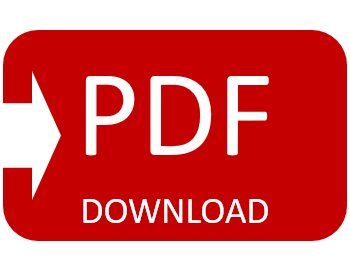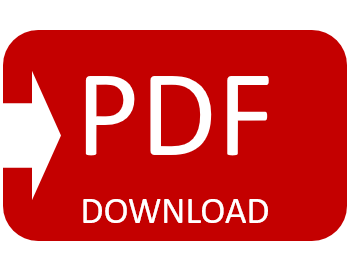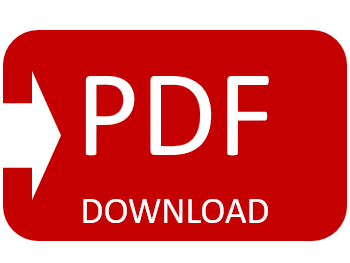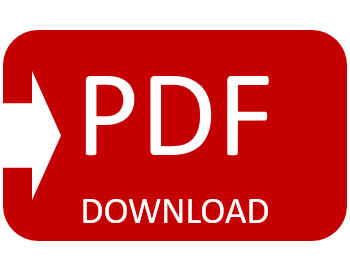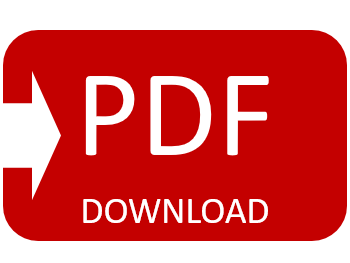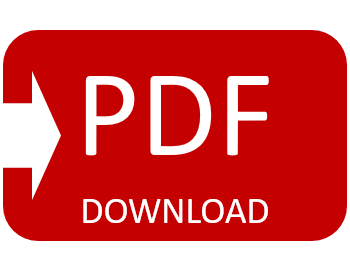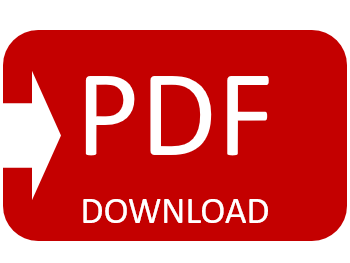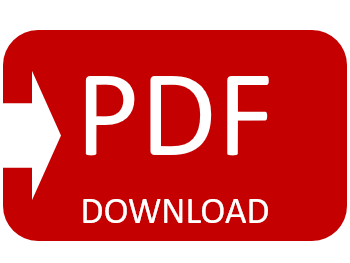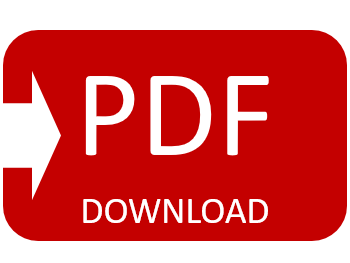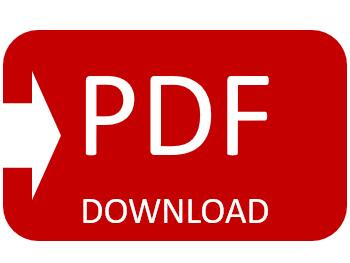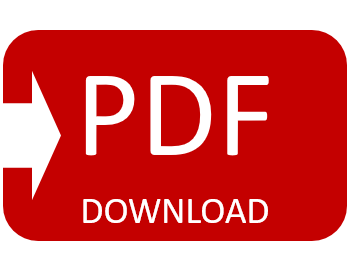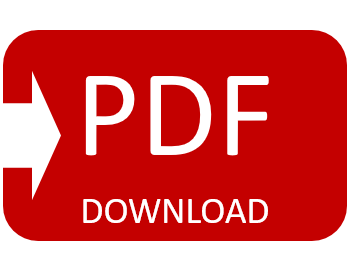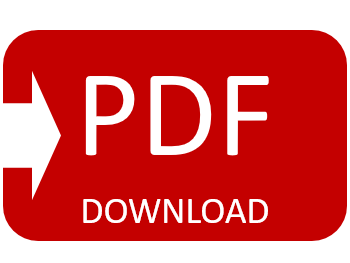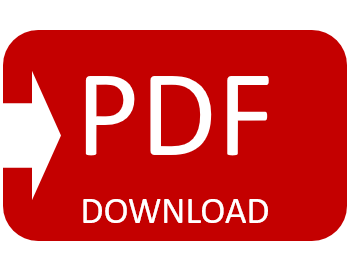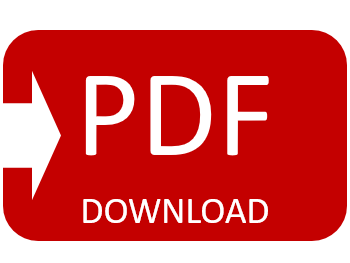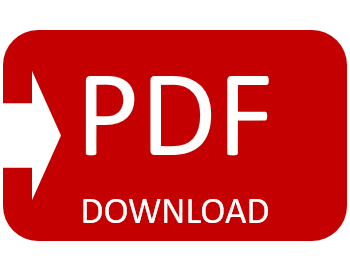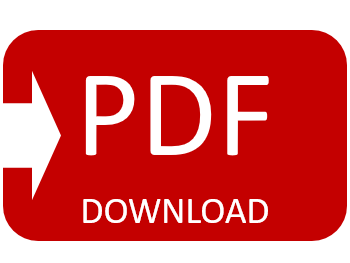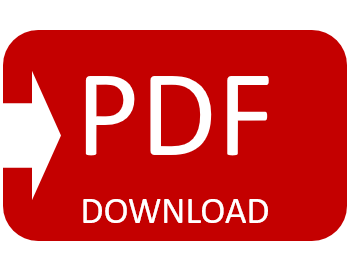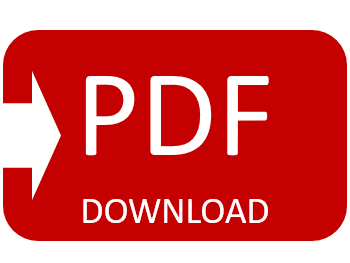SP-INSIGHTS
Risk & operations (1/2025)
Political risk and operational resilience - A business leaders' mitigation guide
This MITIGATION GUIDE provides suggestions to business leaders how they can increase operational resilience and protect earnings.
Introduction
Given the recent developments in early 2025, it is time to reflect where we stand on political risk and the implications this has for businesses navigating through daily challenges.
In January 2017, at the outset of the 1st Trump presidency, we analysed political risk drivers associated with evolving policy frameworks routed in `decreasing political consent`. At that time, we identified four main risk areas:[1]
- Global free trade
- International security framework
- Stability of foreign relations and multilateral political agreements
- Regulation of financial markets
On all four areas we have already experienced the realisation of risks. What has been a risk back then has now become a reality. Some businesses have been prepared, several others were caught unprepared.
However, political risk has not disappeared. On the contrary, we can describe some of the risks more accurately today. At the same time, the degree of risk and uncertainty as well as the impact some risks might have (beyond the recent tariff announcement by the US government) have increased as well. What are examples?
These would short-/medium-term be tariff changes and ad-hoc exemptions (beyond a new normal), new non-tariff policy measures (e.g. im-/ export controls even beyond own jurisdiction), changes of key economic parameters (GDP growth, FX, inflation/ interest rates, unemployment rates) and stability of capital markets, changes of goods and services flows with the potential to be cut out or face new competition but also with the possibility to access new business opportunities. Increasing security challenges might also expose operational vulnerabilities which have been less relevant in the past.
Longer-term, the current conflict might accelerate the development from a multilateral geopolitical framework towards multipolar geopolitical framework with regional hegemons. This then demands answers and potential adjustments e.g. on strategic market presence (and compatibility with the hegemons objectives[2]), operating model & manufacturing footprint, supply chain, IP protection, cyber.
The impact of the recent US tariff announcement
Econometric analysis[3] shows how different countries would be affected by the tariff changes on average. Ironically as it seems, the US next to Canada carries the highest burden (see exhibit). Volatility expectation in capital markets increased by more than 100%.[4] Additionally, inflation would be stimulated medium- to longer-term.[5] As this tariff conflict might seem to be irrational, it only proves the point that there might be additional considerations that determined the decision to introduce them. The good news is that European export-oriented economies seem to be quite robust with regard to US tariffs given the low tariff gap.[6] Obviously, a certain business might be more or less impacted depending on its industry and geographic footprint. Some might even benefit.
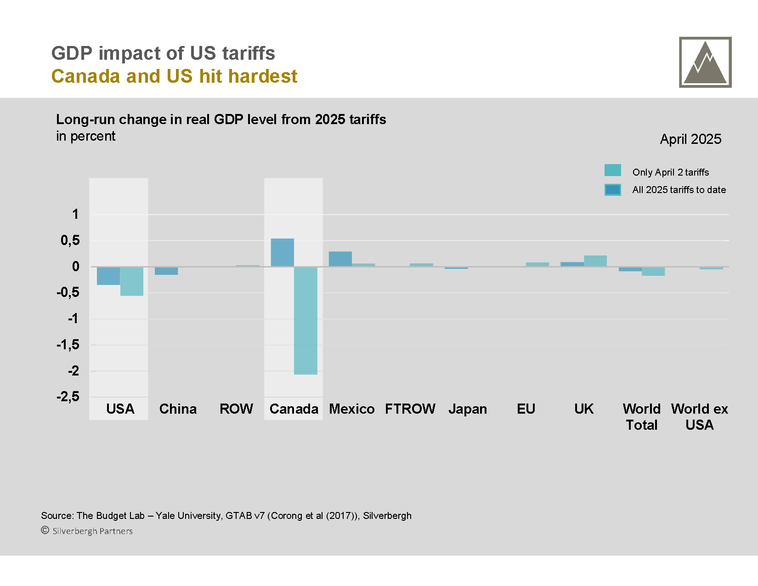
From a business perspective, there may also be upsides. Competitive advantages might evolve due to structural conditions or the ability to act faster and with more flexibility. New market segments might open up. New formations of trading partners might pave the way to new business opportunities i.e. closer ties between Europe and Asia, stronger alignment with Canada and Mercosur.
The trade & tariff playbook
On April 2, business leaders and economists were wondering how the US administration had derived their tariff table and what the longer-term plan might be. In essence, it is just the relationship of US goods exports vs. goods imports to/from a certain country, the country’s trade balance as a measure for the degree of ‘unfairness’. It disregards services.[7] Hence, this is not even a tariff perspective. Imports into the EU have tariffs of 5 percent (vs. 3.3 percent for imports into the US according to the WTO)[8] and are not double digit as the administration claims.The hope that this might be just another spontaneous and chaotic move is not substantiated. The opposite is the case. The policy announcement is in line with plans laid out in November 2024[9] also referred to as ‘Mar-a-Lago Accord’. Author is Stephen Miran who has been confirmed as the Chair of the Council of Economic Advisers (CEA) on March 12. This document gives a flavour on the policy objectives and reads like a playbook on trade policies with the intent to break with established policy patterns.
Some key elements of this document are:
- Aim to ‘reshaping the global [trading] system’
- Devaluation of the USD for higher competitiveness of US goods and with impact on US trade balance on aggregate but also on a country-by-country basis (without risking the role of the USD as a reserve currency)
- Revenue generation through higher tariffs (as these are being paid by the tariffed nation) with the intention to fund the plan to retain low domestic tax rates (expected budget contribution of USD 5 tr over 10-year period)
- Closure of package deals on tariffs and access to the US defence shield by forcing countries from current short- /medium-term bonds to bonds with long tenors (~50-100 years) at low, near zero interest as a ‘price’ for protection
- Intent to enter (also) into unilateral currency adjustment strategies (beyond multilateral approaches)[10] to achieve quick negotiation outcomes
- Tariffs as high as 60% on China and min. of 10% for ROW
- Tariff announcements as a tool to exercise negotiation power ‘by creating fear and doubt’ and to ‘pressure nations’ with the resolution to group countries per their currency policies (quoting Treasury Secretary Scott Bessent).
- A list of trade and security criteria also instrumental for tariff negotiations
- Assumption that tariffs lead to currency offsets of the stronger currency (as experienced in 2018-19 according to early research even though not all transmission channels have been analysed yet)[11]
Arguments along the same lines have been made by Scott Bessent in October 2024 prior to being nominated as Treasury Secretary.[12]
Interestingly, some economic considerations are not dealt with in the document, i.e. the evolution of US businesses’ competitiveness and productivity over time, access to labour at a current unemployment rate of 4.2 %[13] and without stimulating inflation in case manufacturing gets relocated to the US, welfare implications for US households, domestic fiscal measures (with an influence on the trade balance and current account).
Also, behavioural aspects seem to be disregarded e.g.
- Bond market and US treasuries: China is a major investor into US treasuries (among other countries). That it will follow the US administration’s expectations to drop treasuries with shorter tenors for longer tenor treasuries with low interest seems not to be realistic. Additionally, the market has already been damaged. As investors reallocated capital from equity markets into treasuries, prices should have appreciated, and yields should have dropped. The opposite was the case. This can be interpreted as increasing risk premiums for investments which have been considered low risk in the past.
- Credibility of the US as a defence partner: The attractiveness to ‘buy’ protection from a ‘damaged defence brand’ (the US) by investing into long-term low yield treasuries has dropped as well. In the last two months, the US has repeatedly demonstrated its unreliability. From a pure economic standpoint, asking a ‘customer’ under such circumstances to purchase a service for multiple decades can be viewed as a counterparty/ credit risk issue as the counterparty might default on its commitments. As is widely known, the price for buying credit protection is an exponential relationship over time. Beyond opportunity costs for foregone interest, this would be an economic cost to be added to ‘sourcing security’ from a partner. In economic terms, this means that the risk-adjusted costs are already quite high for outsourcing protection today. This is even more the case long-term given the exponential relation. As such, in a ‘make-or-buy’ decision, the ‘make’ gains in attractiveness.
To sum up, it is hard to see that the US administration’s policy objectives on ‘package deals’ are robust and can be implemented as planned.
How to view risk & uncertainty
Different attitudes towards political risk and uncertainty can be observed …
- ‘How do we know what might happen. Even if we would know … what could we really do?’
- ‘As a risk occurs, we will deal with it.’
- ‘Well, it is pretty bad right now. But it cannot remain like that, it will get better.’
We would argue the opposite. We believe decision making should be based on realities rather than hope. Even if perspectives on risk and uncertainty remain imperfect, they provide a view how to mitigate risk and how to protect a business’s operational stability and profitability. This requires ongoing effort and lead time.
For illustration purposes, we suspect that everybody would agree that in this specific situation …
- Less US exposure or an existing US domestic manufacturing footprint (provided international supply chains are not damaged by prohibitive tariffs) would be beneficial for an export oriented European business.[14]
- Fighting of increasing hybrid attacks, protect business systems stability and intellectual property (IP) is a ‘must’ as US agencies redefine their foreign policy, cyber defence and intelligence priorities.
So, what is different in this trade conflict today?
- Flawed baseline: The hike in taxes on multiple fronts is based on counterfactual arguments and the sheer size and speed of implementation is unprecedented. Businesses are immediately affected.
- 2nd order effects also for the domestic economy are tolerated: As the conflict remains, economic 2nd order effects are initiated which are hard to understand ex-ante and hard to control. Businesses will have difficulties to evade changing economic parameters.
- Integration of policy frameworks: Trade and security policies are no longer treated separately. As trade policies are being implemented, adjustments on US national security and defence policies are already ongoing. Negotiations will have impact on businesses on both policy fronts not only with US operations but also with operations outside the US.
- Lingering uncertainty: The willingness to bluntly exercise power, threaten partners, ‘throw established litigation procedures under the bus’ and to leverage uncertainty for negotiation outcomes will lead to a trust erosion and stimulate uncertainty beyond the core conflict. This will incur additional transaction/risk cost for businesses.
Just recognising new realities in the operating environment in a business’s risk inventory will not be sufficient. It is advisable to derive specific initiatives from a set of considerations.
How to increase operational and economic resilience
There are four areas which demand attention for increasing operational and economic resilience with mounting political risk (see exhibit).
- Cost position – It is always good to have an attractive cost position. This is not the reason this is mentioned here. Tariffs (but also not tariff based trade barriers) imply changes to relative prices. As a result, a business might find itself priced out of a market. Alternatively, it would need to swallow some of the tariffs (reducing its export price) to remain competitive. This would be a drain on a business’s profitability. A loss of profitability would trigger a set of cost improvement considerations to stay competitive and profitable.
- Operating model – In order to cope with external shocks creating optionality in the manufacturing portfolio and supply chain allows to adjust quickly by ramping or swapping capacity between different sites. In theory, this sounds easy but is associated with numerous challenges as own resources and skills, suppliers and customers would need to be organized around this objective. Commercial frameworks would need to be synchronized with technical capabilities. The trade-off between low unit costs in stable operations vs. potentially elevated unit costs in flexible operations would need to be managed. Flexibility comes at a cost and additional flexibility costs would need to be justified against the potential benefit. Flexibility might already exist and might only be identified. ‘Producing’ (additional) flexibility would require a cost-benefit assessment. Operational flexibility within given capacity constraints (e.g. workforce) would contribute to inherent operational resilience.
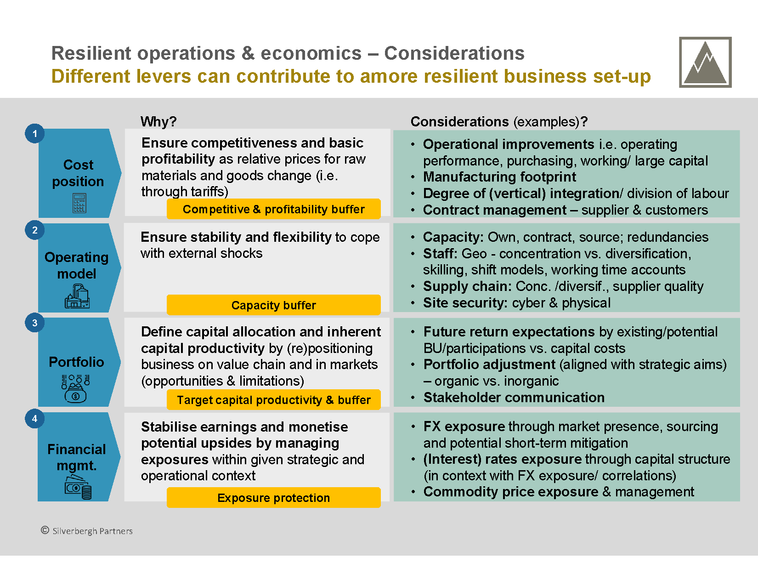
- Portfolio – Companies operating across borders have a well-established rationale how to integrate own operations with partners and supplier. Under the influence of political risk, the conditions under which this scheme was established might no longer hold. Business conditions and/or target capital productivities might be changing. Reviewing underlying assumptions for the current portfolio set-up from time-to-time employing a political risk angle avoids being caught empty-handed with little room to manoeuvre once political risk hits. Capital productivity expectation and buffer can be maintained.
- Financial management – Exposure to financial markets within the liquid horizon[15] needs to be closely managed as political risks initiates volatility. As such this might be a strain or an opportunity to optimise a business’s financials. Thorough management of exposure to financial markets can provide downside protection to a business’s earnings. If risk appetite and capabilities allow, seeking targeted exposure might also contribute to profitability.
Summary and outlook
In the past, companies were also confronted with trade policy changes and security threats. They however operated within the respective policy frameworks negotiated between governments over time. Businesses could adjust to expected outcomes.
Today, established rules of conduct seem to have eroded already for years in some areas and seem to hit a new low of acceptance. Even though governments still act, they have less room to manoeuvre as they are confronted with a faster paced environment. This puts more burden in businesses to cope with the consequences.
Going forward, there is limited evidence today to believe that we will go back to a more stable policy environment that we have experienced in the past. Therefore, businesses need to take a proactive stand with the aim to anticipate political risks and be prepared once they materialise.
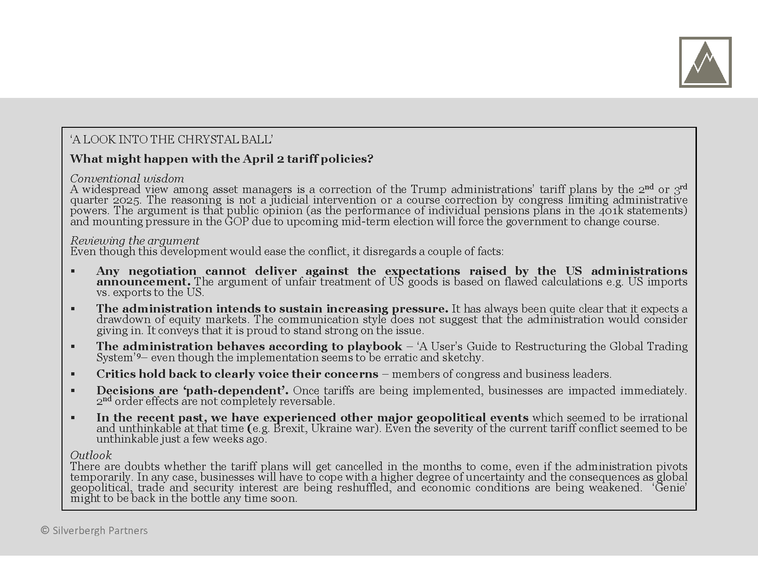
[1] Silverbergh Partners, Coming to grips with political risk, Insights 1/2017, 2017 https://silverbergh.com/files/SP-Insights_1702_Coming-to-grips-with-political-risk_0627w3r9.pdf
[2] We have already some of these compatibility issues/ diverging policy objectives today.
[3] The Budget Lab, Where We Stand: The Fiscal, Economic, and Distributional Effects of All U.S. Tariffs Enacted in 2025 Through April 2; 2025; https://budgetlab.yale.edu/research/where-we-stand-fiscal-economic-and-distributional-effects-all-us-tariffs-enacted-2025-through-april; tariffs modelled ‘in isolation’ which means not tariff responses have been taken into account
[4] VIX index expresses the 30-day implied volatility based on options prices in the S&P 500; https://www.cboe.com/tradable_products/vix/
[5] This poses additional challenges for the Fed. How it will react after a new vice-chair (this year) and a new chair (next year) have been confirmed, remains to be seen.
[6] Flach/ Scheckenhofer, US Reciprocal Tariffs and their Erosion of Global Trade Rules: Implications for Germany, EconPol Policy Brief 71, 2025; https://www.cesifo.org/de/publikationen/2025/working-paper/us-reciprocal-tariffs-and-their-erosion-global-trade-rules
[7] Corith/ Veuger, President Trump’s Tariff Formula Makes No Economic Sense. It’s Also Based on an Error., 2025; https://cosm.aei.org/president-trumps-tariff-formula-makes-no-economic-sense-its-also-based-on-an-error/
[8] World Trade Organisation (WTO), The World Tariff Profiles, 2024; https://www.wto.org/english/res_e/booksp_e/world_tariff_profiles24_e.pd
[9] Miran, A User’s Guide to Restructuring the Global Trading System, Hudson Bay Capital, 2024; https://www.hudsonbaycapital.com/documents/FG/hudsonbay/research/638199_A_Users_Guide_to_Restructuring_the_Global_Trading_System.pdf
[10] Phrasing leaves room for interpretation. Most likely targeted at China.
[11] Joeanne/ Son, To what extent are tariffs offset by exchange rates?, NBER Working Paper Series, 2021; https://www.nber.org/system /files/working_papers/w27654/w27654.pdf
[12] Entering the Fall 2024, Alarming Signs? – Fireside chat with Scott Bessent; https://www.youtube.com/watch?v=D18IRACRJio
[13] March 2025 (tradingeconomics.com)
[14] On the contrary establishing production capacity in the US to cope with the tariff regime would incur additional costs and potentially stranded investments if the tariff regime is revised afterwards.
[15] Time frame in which financial instruments have a sufficient liquidity and are therefore tradable without incurring liquidity risk and premiums.
Capital markets (1/2024)
Restoring environmental capital markets
Unlocking the potential of capital markets will be pivotal to fund the climate transformation. Although early phases of market formation have been promising, setbacks have been experienced. As such, market mechanisms have been damaged – key markets have been shrinking or face disproportional growth projections.
Recognizing initial design flaws would allow to regain trust. As a result, inflow of funds would be stimulated. Business opportunities would evolve and the prospects to cope with the climate crisis would improve.
Environmental markets can unlock capital for climate transformation
Environmental markets have been formed some years ago and have exhibited gradual growth with at times some corrections. There has been a constant debate on market design, characteristics of the traded underlying (product) and the investability/ bankability of new environmental asset classes as well as the roles of different market participants.
In the spotlight of the debate are two key markets
- Voluntary Carbon Market (VCM) in which carbon offsets are being traded[1]
- Markets for ESG investments as defined by the respective issuers[2]
- …
We do not intend to repeat arguments already made e.g. the role and relevance of rating agencies and indices, portfolio composition, investment focus – status quo vs. change, credibility of measurement and assurance mechanisms, controls, conflicts of interest, self-regulation vs. government regulation … . Neither do we try to be complete and exhaustive.
Instead, it is time to reflect and identify whether adjustments are needed.
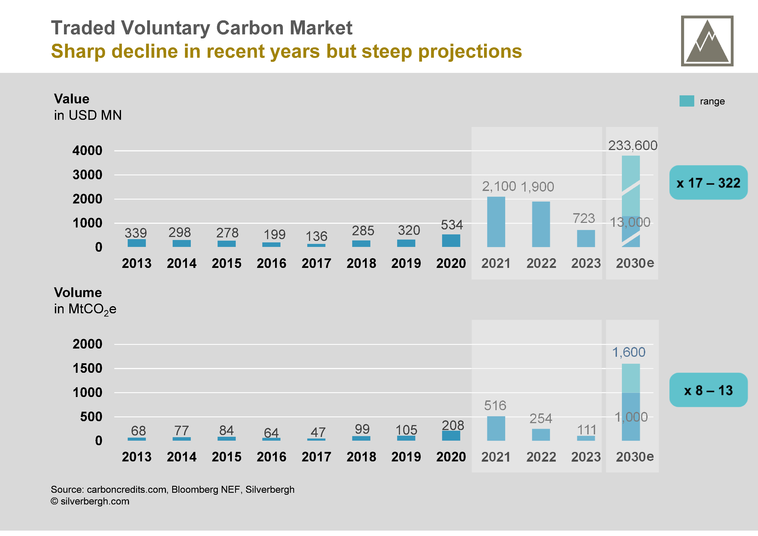
After the heydays, the market mechanism has been damaged
For both markets, the 2019-2022 period has been very successful. Both markets have grown significantly and have gained an increasing role in investment and public policy frameworks and debates. As of 2022, investors (and customers) have increasingly questioned market integrity and promises made. In both markets there are doubts whether the climate/ sustainability performance of the respective asset classes will live up to expectations.
Additionally, the …
- VCM markets and purchases of offsets will not relief the buyer from decarbonizing his value chain to meet net zero commitments
- ESG investment markets may not necessarily provide superior performance, nor will they necessarily mitigate long-term risks.[3] In the majority of ESG portfolios, giant tech stocks have been a driver of financial performance.[4]
As a consequence, institutional investors are increasingly hesitant when considering exposure. In the VCM, investors more often turn a blind eye on Nature Based Solutions (NBS) but favor Engineered Solutions (ES). Whether these investments will in the end be successful is highly questionable given their high CO2e abatement costs.
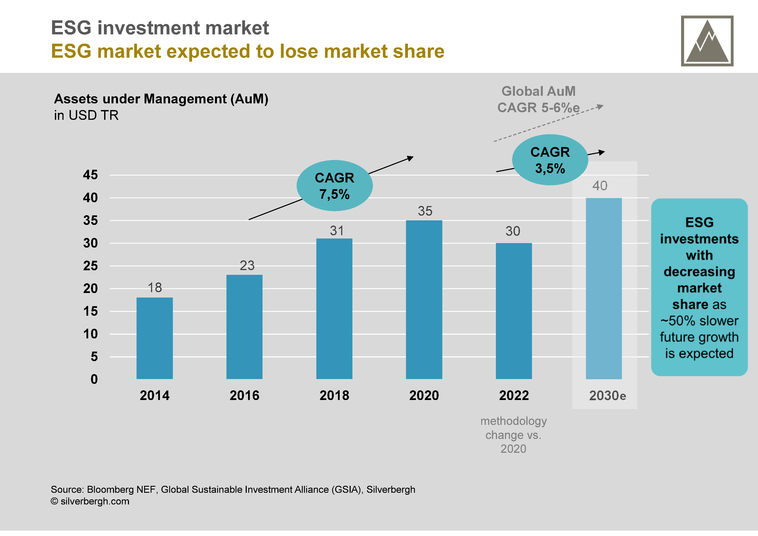
Damaged market mechnism
As a matter of principle, the more accurately a good or an asset class can be defined, the better it can be assessed by buyers and investors. This is key for price discovery. As a result, high quality markets will gain liquidity meaning the market size will grow as purchases/ investments will be facilitated.[5]
On the contrary, if the value of an asset is not clear, the market will assign discounts to the asset. Not being able to define climate performance or risk adjusted financial performance would be reasons to assign discounts. Also, a lack of binding valuation practices and synchronization to financial calendars of companies/ investors would be a burden to determine the intrinsic value of the asset. It also raises a set of additional technical issues which need to be addressed.[6]
In the VCM, the contribution of instruments traded to climate performance has not been clear mainly due to simulation-based product design and multiyear true-up mechanisms.[7] As such this raises accounting challenges and hurdles to synchronize this asset class with financial calendars. Additionally, the lack of quality prohibits the evolution of financial markets (cash settled instruments based on the physical underlying).
In ESG investment markets, portfolio construction relies very much on ESG ratings provided by agencies. Conceptually, this is associated with some challenges. Different ESG indices are not correlated and consequently do not lead to the same outcome.[8] ESG ratings are based on scoring approaches integrating and weighting a set of parameters meant to capture environmental, social and governance aspects of the company. The capital allocation outcome of these portfolios is not entirely clear.
If for example the investor is in favour of contributing to reducing climate warming, he might want to invest into a portfolio which reflects the traceable reduction of greenhouse gases (GHG) linked to financial performance. Any other indicator would be a delusion to his investment objective. Investing into a status quo would favour low carbon businesses but might not be as effective to contribute to GHG reductions. Hence, investing into any ESG portfolio may not be the most efficient way to allocate capital.
Other investment objectives – e.g. on the ‘S’ and ‘G’ dimensions - could be dealt with by introducing exclusions or hurdles outside a weighted set of parameters.
The implications from the above observations are substantial:
- Inefficient allocation of capital, disincentive for ‘climate investors’,
- Lack of price discovery and risk management approaches,
- Limitations of instruments for GHG reductions available to companies,
- Lost opportunity for asset managers,
- …
Equity, debts and mature commodity markets have experienced an evolution leading towards liquid and credible markets today. This took years or even decades. Although this knowledge exists, it is astonishing that market participants and institutions do not ‘pivot’ sufficiently facilitating markets to recover going back to their earlier growth trajectory.
If the conditions would be different, we could sit back and observe. However, as societies we are working against a shrinking ‘GHG budget’ to keep global warming below 2 ˚C, we have no time to waste. We simply cannot afford to ‘take capital markets out of the equation’. We need more capital markets to unleash capital funding the climate transformation. Therefore, credibility in existing markets needs to be re-established paving the way for more environmental capital market activity.
Fixes and innovations
Two approaches might be followed entailing a set of activities (examples).
First, fixes need to be applied to existing markets as indicated above. If market participants want to avoid regulatory intervention, they are well advised addressing today´s deficiencies. Even though financial market regulators have been holding back, environmental markets are on their radar screen.[9]
Second, there are ample of opportunities for environmental product and market infrastructure innovations.
- In the VCM, participants would benefit from credible markets for carbon offsets and deeper financial markets linked to high quality underlyings. This market is fundamentally broken today.[10] Activities of market participants – especially the supply side - do not provide sufficient evidence for optimism. Their ability to fix the remaining issues without regulatory intervention seems to be limited. However, there is awareness that accounting practices need to be amended as a basis for regaining credibility.[11] Additionally, companies who have committed to a net zero journey cannot rely completely on offsets but must reduce GHG emissions within their (own) value chain and adjacent value chains. Although they can reduce their financing cost through environmental debt instruments already today, creating a market for bankable ‘GHG in-setting’ could be a new perimeter of asset classes accelerating the journey to net zero.
- In ESG investment markets, linking portfolios more stringently to improvements on the ESG dimensions might attract additional capital. Carbon accounting would need to be upgraded, new indices and benchmarks would be required. Biodiversity as an upcoming ESG theme is not widely reflected yet in investment approaches but a demand-pull for portfolios integrating this rationale prominently can be expected.
ESG investment markets have in the past adapted to changing requirements – sometimes with regulatory influence. If awareness is turned into action, markets should be able to provide more targeted quality environmental investment products soon.
EU CSRD regulation and taxonomy also provides a new type of infrastructure and data which could be instrumental for environmental capital market innovations.
Summary and outlook
The inception of environmental markets has been promising. However, the recent years have revealed deficiencies in market mechanisms at work in environmental capital markets. This is a limiting factor for climate performance and financial prosperity as it limits access to funding and capital market growth.
Now is time to ’pivot’ – fix existing deficiencies and introduce financial product and market innovations. A collaborative approach between market participants can speed up the process and adoption of capital market frameworks.
There is a lot to lose BUT also a lot to gain!
[1] For this debate we stick to overall market trends and do not discuss individual segments or compliance markets
[2] And as classified by the Global Sustainable Investment Alliance (GSIA); investments include environmental considerations but might have a bias towards other ESG dimensions, the ‘S’ and/or the ‘G’
[3] Le Sourd, Does ESG investing improve risk-adjusted performance?, Nice, 2023
[4] Silicon Valley buoys ESG funds, Financial Times, London, 12 July 2024
[5] Assuming that demand exists
[6] Accounting for Carbon Credits, International Swaps and Derivatives Association (ISDA), New York, 2023
[7] Probst et al, Systematic review of the actual emissions reductions of carbon offset projects across all major sectors, Zurich, 2023
[8] Berger et al, Aggregate Confusion: The Divergence of ESG Ratings, Zurich, 2022
[9] SEC, The Enhancement and Standardization of Climate-Related Disclosures for Investors, S7-10-22, Washington D.C., 6 March 2024
[10] Prices have not bottomed out yet decreasing from USD 21.28 (Jan 2022) down to USD 1.85 (Jan 2024) and USD 0.23 (Sep 2024) for CBL Nature-Based Global Emissions Offset Futures on NYMEX
[11] Kaplan et al, Accounting for carbon offsets –Establishing the foundation for carbon-trading markets, Harvard Business School, Boston, 2023
Unlocking the potential of capital markets will be pivotal to fund the climate transformation. Although early phases of market formation have been promising, setbacks have been experienced. As such, market mechanisms have been damaged – key markets have been shrinking or face disproportional growth projections.
Recognizing initial design flaws would allow to regain trust. As a result, inflow of funds would be stimulated. Business opportunities would evolve and the prospects to cope with the climate crisis would improve.
Unlocking the potential of capital markets will be pivotal to fund the climate transformation. Although early phases of market formation have been promising, setbacks have been experienced. As such, market mechanisms have been damaged – key markets have been shrinking or face disproportional growth projections.
Recognizing initial design flaws would allow to regain trust. As a result, inflow of funds would be stimulated. Business opportunities would evolve and the prospects to cope with the climate crisis would improve.
Unlocking the potential of capital markets will be pivotal to fund the climate transformation. Although early phases of market formation have been promising, setbacks have been experienced. As such, market mechanisms have been damaged – key markets have been shrinking or face disproportional growth projections.
Recognizing initial design flaws would allow to regain trust. As a result, inflow of funds would be stimulated. Business opportunities would evolve and the prospects to cope with the climate crisis would improve.Unlocking the potential of capital markets will be pivotal to fund the climate transformation. Although early phases of market formation have been promising, setbacks have been experienced. As such, market mechanisms have been damaged – key markets have been shrinking or face disproportional growth projections.
Recognizing initial design flaws would allow to regain trust. As a result, inflow of funds would be stimulated. Business opportunities would evolve and the prospects to cope with the climate crisis would improve.
Corporate Governance (1/2023)
Climate governance: Recoupling the value and sustainability perspectives
But how could a solid company performance and attractive financials be secured by recognizing the transformational nature of today´s business context and at the same time staying focused on the companies' climate agenda?
The article dicusses how these objectives could be achieved by innovating and adapting a companies' governance framework guided by a value perspective. A governance structure should support decision making and business leasders rather than erecting new hurdles for conducting business.
Commodity risk management (1/2022)
Navigating through turbulent markets
Managing commodity economics and exposures protecting company financials and decreasing vulnerability
The war in the Ukraine has caused turmoil not only in energy markets but also in broader commodity markets. As such not only companies’ financials are at stake, structural risk exposures and vulnerabilities have surfaced.
What to expect ... A new normal ...
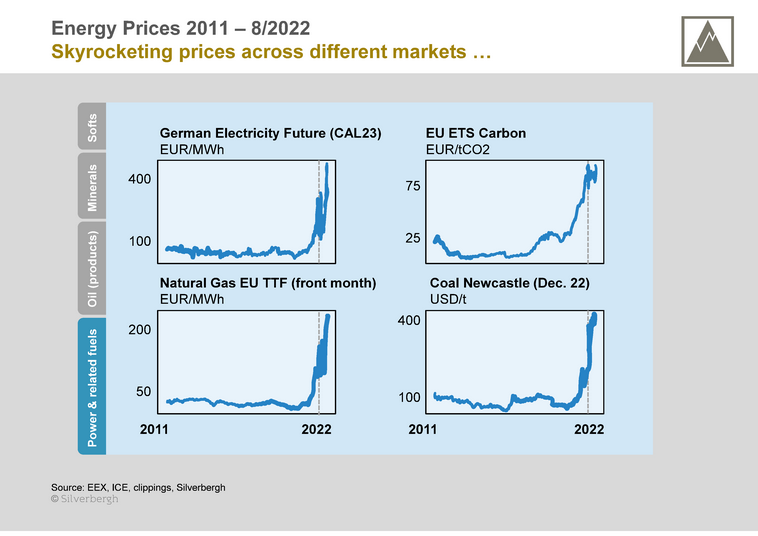
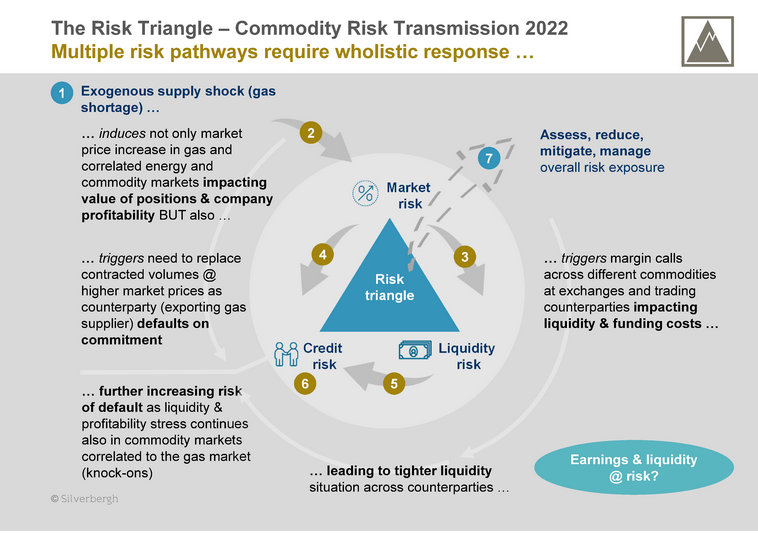
Adjusting risk management systems
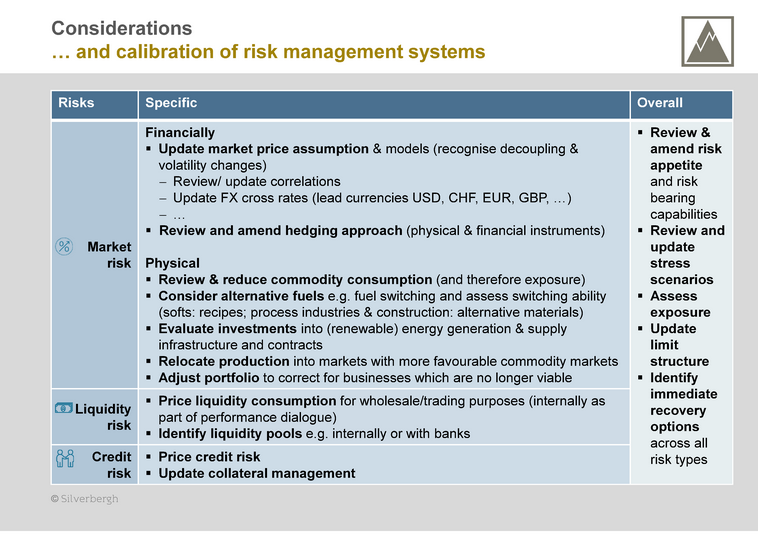
Evolving risk management agenda
In February 2022 the war in the Ukraine started adding another element of political risk[1] to the value management agenda. As part of the conflict, Russia has limited gas shipments to Europe. Oil as well as oil product shipments get relocated to non-European destinations. This changes supply-demand economics. Therefore, energy prices have exploded.

For years energy experts have warned that as energy systems and supply are being transformed, a certain level of diversification of primary energy supplies and generation technologies should be maintained. These considerations have not been adequately recognised in energy policy frameworks.
However, a scenario in which Russian gas supplies would terminate did not really exist. Throughout the cold war, Russian gas, oil and coal shipments have been stable and reliable since the early 1970s. There has never been any indication that at some stage energy shipments might be politicised.
Favourable prices for piped gas shipments vs. LNG landed prices were also too tempting to turn a blind eye on energy diversification. A public debate about the need to diversify which started in Germany in the early 2000s ceased.
On the contrary, countries like Spain and the Baltics have been diversifying their gas supplies also driven by a different risk assessment compared to central European countries.
Signs of pre-war constraints in the European energy system – gas and electricity – have passed very much unnoticed by the broader public. As such, it is unlikely that especially energy commodity markets will soon return to a pre-crisis status quo.
Will there be a new normal and how might it look like?
It can be expected that energy prices will plateau on a higher level medium-term given decreasing global investments into energy supply in the last seven years after peaking at USD 1.9 Trillion p.a. in 2014.[2] In this environment, operational and politically induced supply shocks add to price volatility. This again will require to assign more economic capital for interacting with wholesale/trading markets.
Potential shocks in the energy system have been anticipated for years by some companies in their risk inventories and through stress tests. Even these companies are challenged managing the consequences of loopy commodity markets today.
Companies which are not as well prepared are now confronted with previously unknown risk exposures and a limited set of mitigation options. Therefore, they face additional hurdles to navigate through crisis.
After updating financial exposures and initiating potential mitigation actions, much more fundamental business model and portfolio questions might enter the agenda.
Risk transmission mechanism
What is at stake? Estimates of margin calls in European energy markets (without government intervention – prices or liquidity support) are estimated at USD 1.5 Trillion.[3]
How are companies affected?
The risk triangle provides insights how risk impacts into company financials.

First of all, there is an exogenous gas supply shock, a massive contraction of gas supply with impact on all European countries.
Second, the gas supply shock manifests as market risk not only in the gas market but also in related commodity markets through spill-over effects e.g.
- Power generation – conversion economics (marginal producer in merit order)
- Oil/ oil products & coal – fuel switching
- Softs (and food production) – fossil fuel substitution (correlated with energy markets) and input factor (FMCG sector)
The value of existing positions is changing, and earnings get under pressure with rising cost positions.
Third, market risk translates into liquidity risk if margin loans of counterparties ‒ exchanges and wholesale/ trading counterparties ‒ move beyond a predefined threshold. This affects the counterparties credit process. Either more collateral is provided or the exposure with the counterparty is reduced by liquidating of positions with the counterparty.
Fourth, market risk also translates into credit (counterparty) risk if a supplier defaults on his commitment. In case of defaulting supply, replacement supplies need to be sourced from the market at higher costs.
Fifth, liquidity stress adds to financial instability.
Sixth, financial instability layers on additional credit (counterparty) risk. It might be analysed whether this is associated with concentration risk (e.g. other contractual relationships with the counterparty; increasing ‘Probability of Default (PoD)’ and ‘Exposure at Default (EaD)’.
Seventh, wholistic and potentially migrating exposures should be understood to reduce, mitigate and manage the overall risk exposure.
Adjusting risk management systems
For each risk type ‒ market, liquidity and credit risk ‒ a specific response is required to update risk assessments and to mitigate and manage the risks.
Across all risk types a broader response is also required. An updated risk assessment and stress testing informs immediate recovery activities with the aim to limit and mitigate risk exposure and to protect company financials.

Once the basis for a more elaborate risk dicussion on top management level has been established, it is key to update the risk appetite statement of the company defining the amount of risk and the type of exposures the company is comfortable to carry.
Recent events might demand amendments to the companie’s risk taking behavior in order to maintain the companies financial resilience and to align with shareholder expectations.
Some companies have layered on risk which they have not even been aware of and which surfaced in the last few months. In some cases even companies’ integrity has been at question and production activities have been terminated.[4]
Evolving risk management agenda
Going forward, risk assessments and risk appetite updates might also inform potential structural portfolio amendments beyond immedate tactical measures.
Especially process industries are currently reviewing their European manufacturing footprint and might consider to re-locate operations overseas.
Are all businesses still viable in today`s envinronment? What would need to change and what would one need to believe in order to continue European operations and businesses which are currently challenged.
Outlook
The war in the Ukraine causing energy prices to surge meets an economic environment which can be characterised by an increasing level of uncertainty.
Supply chain restrictions remain, geopolitical conflicts firm up globally, critical infrastructure is increasingly targeted and exposed to vulnerabilities. High energy prices contribute to economic downturn and increasing producer and consumer prices. Fiscal stability is challenged by massive government bail out programs leading to debates how to share burdens among European Union member countries.
Just updating commodity risk assessments and company positioning might fall short of the perspective which needs to be established even though some markets are correctiing already after the supply shock. The broader economic environment affecting also commodity markets should be anticipated. This enables companies to protect their financial performance and to increase their resilience as they enter into exposures and make structural changes to their business portfolio.
[1] See also Silverbergh Partners: Coming to grips with political risk; SP-Insights, 2/2017
[2] IEA: World Energy Investment 2017; IEA: World Energy Investment 2022
[3] Bloomberg: Equinor Warns of $1.5 Trillion Margin Calls: Energy Update, 6 September 2022
[4] The Economist: How to deal with Europe’s energy crisis, 8 September 2022
Climate Transformation (3/2021)
(reprint) in: Der Staat in der grossen Transformation; Jahrbuch Normative und institutionelle Grundfragen der Ökonomik, Band 19, Marburg 2021, S. 283 - 307
Regional Climate Management in line with COP21 targets
Numerous global regions and municipalities have declared «climate emergency» or consider doing so. Therefore, public administrations are tasked with implementing these new policy goals, integrating it into the administrations day-to-day management approach and resolving potential conflicts and trade-offs with other policy areas. As administrations will be held accountable for their results, they are well advised to decide on a management framework they want to follow. This article provides some suggestions administrations may want to consider as they implement their climate agenda. They can leverage experience from large corporations which continuously manage transformations successfully. A post COVID-19 social and economic environment will open new opportunities for transitioning towards a carbon light economy which should be addressed by administrations in their approach.
(COMPLETE ARTICLE: PLEASE DOWNLOAD BY CLICKING ON THE LINK TO THE RIGHT; IN GERMAN ONLY)
Climate Transformation (2/2021)
Carbon Neutrality by Silverbergh Partners
Silverbergh Partners is committed to contribute to slowing down global warming in line with the 1.5 °C degree pathway and the UN Sustainable Development goal 13. We will achieve carbon neutrality in our financial year 2020/21.
We monitor our greenhouse gas emissions (GHG) – Scope 1,2 as well as Scope 3 according to global standards as defined by the GHG protocol in Paris. Hence, we capture greenhouse gases beyond carbon expressed in kgCO2eq.
The main emissions are caused by office space and business travel. Additionally, we include emissions from operating electronic office and cloud equipment. In the pandemic we also include emissions from domestic energy consumption related to working from home under our Scope 3 perimeter.
We have amended our electricity purchasing agreement. As such 100% of the electricity consumed comes from renewable sources.
We neutralize the 2020/21 carbon footprint by investing into carbon offset projects. These projects are certified by international standards (like The Gold Standard) and rely on nature-based solutions removing carbon from the atmosphere in support of a net-zero economy.
Transportation (1/2021)
Superyachts − On the way to sustainability ...
The layout of superyachts follows to a large degree traditional concepts - hull designs and combustion engines. Key industry stakeholders and owners have joined forces to kick-off the jouney towards sustainable superyacht designs. A rating system (SEA Index) has been established measuring the carbon intensity of superyachts. This rating facilitates the dicussion in the industry around future superyacht design specifications and is increasingly receiving attention as a reference for new orders.
For further information please reference The Superyacht Eco Association (SEA): https://superyachtecoindex.com/what-is-it/
Infrastructure (2/2020)
(reprint) in: Transparency Task Force: Why we must rebuild trustworthiness and confidence in financial services; and how we can do it; London, May 2020, p- 229-233
Infrastructure investing - Increasing financial stability and prosperity
Infrastructure has evolved as an investment asset class. With increasing investment needs, the participation of private capital has increased as well. However, a funding gap remains putting economic development at risk. The 2008 financial crisis has shown that infrastructure contributes to higher resilience of the financial services sector. Hence, policy makers are well advised to further improve the conditions for privately funded infrastructure build-out. This will improve confidence in financial services offerings as it stimulates economic benefits and increases portfolio stability.
Situation today
Infrastructure investment needs have increased over time. In the late 1990 annual global investment needs were below USD ~ 2 TN.[i] Until 2040 they are expected to increase to nearly USD ~ 4 TN annually. The Infrastructure Outlook of the G20 Global Investment Hub expects total infrastructure investment needs of USD 94 TN until 2040. This implies a funding gap of USD 15 TN.[ii]
The case for privately funded infrastructure
Therefore, stimulating infrastructure investments and closing the funding gap will contribute to GDP growth. Longer-term GDP gains might even be higher if these investments are not financed by public budget deficits.[iii]
From an investor´s perspective, infrastructure is less risky than corporate bonds. It exhibits lower default rates, higher recovery rates and better ratings compared to corporate bonds. Moody´s rated 92% of infrastructure securities ‘investment grade’ compared to 42% of corporate bonds.[iv] Additionally, core infrastructure functions as a diversifier in investment portfolios vs. stocks and bonds given it`s neutral to negative correlations.[v]
This is a set-up for a win-win situation.
On the one hand, the public sector is challenged to finance its traditional obligations.
On the other hand, employees are asked to increase their provisions for retirement. This provides capital to finance infrastructure build-out.
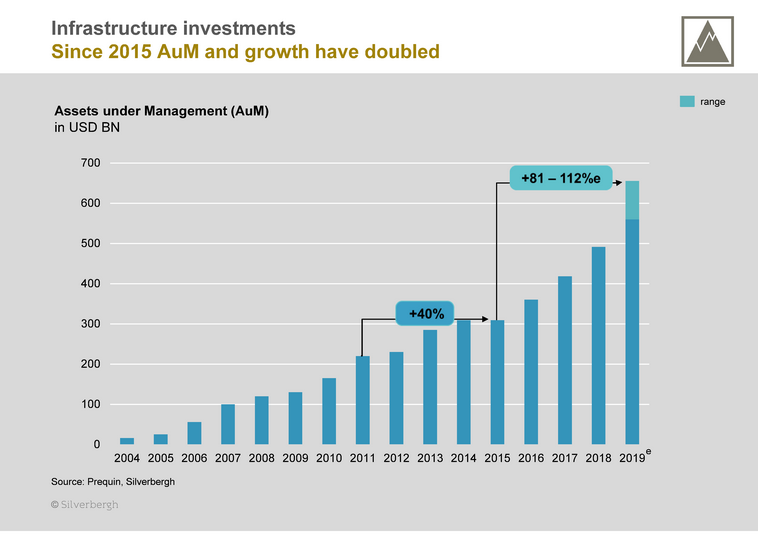
What investors require …
In order to match longer-term cash-flow profiles and liabilities, investors ̶ especially insurance companies and pension funds ̶ allocate capital to infrastructure in particular through infrastructure debt. As such they do not seek maximum returns but stable and realiable returns. They require …
- Visibility over high quality infrastructure investment project pipelines
- A stable regulatory framework mitigating political and regulatory risk. This refers to value levers directely linked to project performance like revenues, costs and contextual considerations like tax regimes and trade policies.
- Transparency over project performance across the project lifecycle and on the key volatility drivers with the ability to influence project returns.[vi]
… and what is lacking
From a European perspective, significant progress has been made to develop infrastructure markets. The European Fund for Strategic Investments (EFSI) in cooperation with the European Investment Bank (EIB) has contributed signficately not only through capital commitments to this development but also through a clear institutional framework. However, member states might further develop their national frameworks allowing for more investment activity and deal flow.
- Project pipelines: Pipelines vary in quality which translates into exposure to volatility e.g. geological conditions, construction and technology risk, uncertainty about planning processes and revenue recognition.
- Regulatory framework: At times the investment process lacks certainty and transparency. Hurdles have been a) post investment changes to initial revenue/tariff schemes (renewable energy in Souther Europe), b) opposition to facilitate private co-investments (Germany), c) unclear risk sharing mechnisms or d) dependency on 3rd party stakeholders.
- Project performance: There is a lack of clarity how to measure project performance and how to compensate investors also in the case of changing project assumptions.
Digitization as a risk management lever
Digitization of infrastructure can take a key role in helping to reconcile public and investor interests. Measuring performance has never been easier and available at lower costs than today. Sensors are increasingly integrated into fixed and mobile infrastructure (rolling stock, locomotives, ships etc.). Infrastructure performance data (e.g. usage, status, cash flows) can be attributed to the respective assets through IIoT[vii] platforms. This allows to disaggregate risk-return profiles and to reliably and timely document investment performance. [viii]
Implications for the regulatory agenda
Regulators and policy makers can enact on a set of initiatives already today.
- Provide updated high-quality project pipelines: Assess and evaluate each project from an investor’s perspective. Invest in narrowing down volatility drivers and develop a mitigation response.
- Upfront de-risk (some) infrastructure projects: Australia and New Zealand develop infrastructure projects to operational maturity. Once they are in operations and have proven to be successful, they are sold. The public sector collects revenues which are then being used to further develop the infrastructure pipeline.
- Establish a risk-sharing scheme and conflict resolution mechanism and integrate them into contractual frameworks: For illustrative purposes let’s take transportation. It is often the case that traffic forecasts are not met. This results into conflicts between governments and investors as a deterioration of this parameter impacts revenues and costs. As a consequence, investments and the associated public service might be at risk. Hence, it is advisable to seek conflict resolution mechanisms on predefined parameters which lead to adjustments in compensation if historic expectations are not met.
- Review capital requirements for new evolving infrastructure asset classes and risk-return profiles: Digitally tracking and reporting operational and financial performance allows to refine the understanding of risk profiles. This may justify differentiating capital requirements.
Summary
Maturing institutional and contractual frameworks by integrating risk-sharing schemes and conflict resolution mechnisms will create a win-win situation. Infrastructure funding gaps will be closed and the resiliance of the financial services sector will increase with direct benefits to investors i.e. pensioners and consumers.
[i] Credit Suisse (2016), Airport Anyone? Investing in Infrastructure
[ii] Global Investment Hub – A G20 Initiative, Investment Outlook (2020), refers to 2016 – 2020 time frame; https://outlook.gihub.org/
[iii] Jeffrey M. Stupak (2018), Congressional Research Service, Economic Impact of Infrastructure Investments
[iv] Moody`s (2017), Default research: Infrastructure Default and Recovery Rates, 1983 -2016
[v] JP Morgan Asset Management (2019), The correlation conundrum: Why diversification is more than “stocks vs. bonds”
[vi] Silverbergh Partners (2017), Managing Infrastructure
[vii] Industrial Internet of Things
[viii] Boris Galonske (2018), The Future of Transportation Executive Briefing 2018 (p. 156 -159), The Evolution of Smart Transportation Infrastructure
Infrastructure (1/2020)
Weathering the storm - Establishing a playbook for critical infrastructure operations
The coronavirus exposes critical infrastructure to a risk environment which is unprecedented in recent history. In order to maintain resilient operations establishing a playbook how to run critical infrastructure these days is key.
Situation today
A pandemic has been part of risk inventories of large corporations for several years. However, the accelerating speed with which the coronavirus spreads across global regions comes as a surprise. Research organisations and networks uncover new facts almost on a daily basis.
Medical researchers fast-track efforts to come up with medical interventions which in the best case will be available by year end.
Politicians and financial experts carve out policy mechanisms targeted at coping with the economic consequences of the pandemic – short-term and longer-term.
Although corporations also need to review their exposures and identify mitigation mechanisms, maintaining robust operations of critical infrastructure (e.g. IT, chemical plants, utility assets, power plants, chemical plants & sites, …) today is critical.
Hence, as vulnerability of operations increases, stabilising the management response and reducing complexity is key in order to maintain operational resilience.
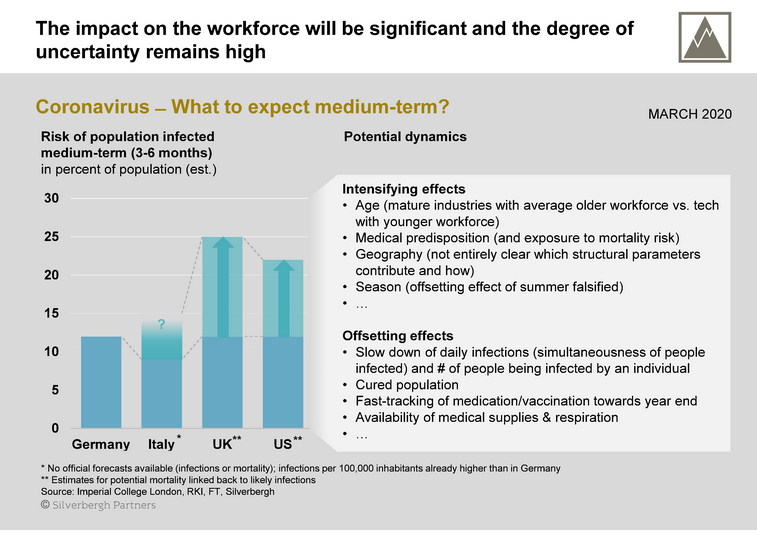
What stakeholders expect
Clearly, exposing critical infrastructure to unnecessary vulnerabilities not only puts companies businesses at risk but may compromise expectations of the broader stakeholder environment. Stakeholder expectations are the following:
- Customers: Access to services (whether these are utility services, infrastructure services to large industrials or payment operations in case of banks etc.).
- Shareholders: Profitability of business and stable cash flows.
- Employees: Stability of employment and compatibility of private and professional demands.
- Regulators & public: Stability of operations & uninterupted service; compliance with general rules how to conduct business.
Under disruptive conditions as we experience them today, some of these expectations are conflicting. Resolving these conflicts requires an assessment of trade-offs, resolution options and active communications with all stakeholder groups. Communication will not only have to address needs and requests tactically. It has also to be set up to rationalise and document management decisions and behavior after the crisis.
How risks materialise
Understanding how risks materialise will help to guide developing adequate responses. Some risk exposures triggered by the pandemic are worth reviewing (examples).
On company level: A company provides the business and operational framework for critical infrastructure operations and the associated businesses. As such key risks are …
- Inherent business profitability risk and financial consequences driven by the evolution of revenues vs. costs.
- Credit/ counterparty risk (delayed cash-inflows and exposure to defaults of counterparties or replacement risk).
- Reputational risk and related financial consequences.
- Operational risk with regard to core admininstrative processes and responsibility for the overall operating framework.
- Liquidity risk and implications for refinancing opportunities and refinancing costs.
- …
On operations and asset level: On this level, management needs to maintain the ability to operate critical infrastructure and assets in order to serve customer needs.
- Staff availability risk (own personnel).
- Procurement stability risk (services incl. agency staff and utility services, consumables, investment goods and parts) driven by operational risk of non-availability and counterparty/ credit risk in case of default.
- Shipment volatility risk driven by ramp downs or cycling of customer demand influencing sales and implying operational risk associated with maintaining the minimum viable level of critical asset operations and financial risk as revenues and costs are impacted.
- Cyber risk may impact stable asset operations as more staff requires remote access to company networks. The likelihood of cyber attacks increases.
- Risk of social unrest and impact on integrity of sites and interference with core operations. Also likelihood of sabotage increases as social instability rises.
- …
Mitigation activities might reach across several of the above risks. They would need to be detailed out specifically addressing every risk driver but could be aggregated up afterwards. Examples of mitigation actions are
- Amended work/ shift models (including multi-skilling of staff). This however requires training upfront.
- Insourcing of activities and hence less dependence on contractors or staff remotely located.
- Customer assurance and agreement with customers on service levels and adjustment of demand. This allows concentration of own activities in certain sites/ locations. Potentially, value-added services and products could be offered helping customers to handle todays situation.
- Workforce motivation and relations by offering relieve from daily burdens and by providing transparent and timely communication.
- Build up of redundancies (e.g. procurement contracts with optionality or sourcing of critical asset components; diversification and tiering of suppliers; risk assessment of critical supplies and parts with options to establish own stocks, …).
- Financial hedging pegged to procurement & sales of commodities or exposure to exchange and interest rates (on company level).
- …
Playbook for critical infrastructure operations
The objective of a playbook for critical infrastructure operations is to create stability in the management response to an environment which is exposed to fundamental discontinuities.
- Faster response to operational needs and a rapidly evolving risk environment.
- Reduction of operational instability by introduction of amended (temporary) operating framework stress-tested against risk-drivers, introduced and practiced prior to materialisation of risks.
- Clarity of responsibilities and accountabilities (line organisation vs. committees/ organisation by exception).
- Reduction of complexity through a clear protocol how to handle the situation across organisational boundaries.
- Improved management oversight through clear milestones by initiative/ workstream and reporting format (including KPI).
- Mitigation and containment of financial consequences by integrating risks on operational and asset level into corporate financial risk perspective.
- Documentation of management decisions for post crisis communication.
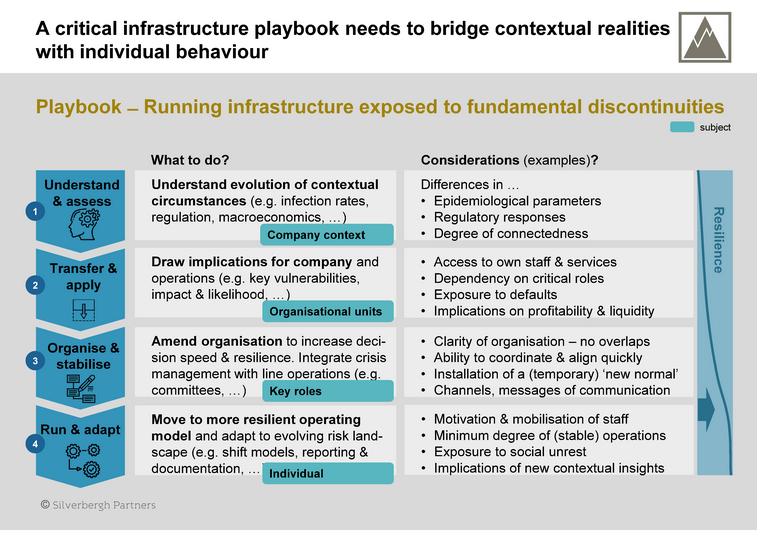
How should a playbook for critical infrastructure operations be established?
- Understand & assess: The evolution of how the pandemic spreads should be continuously monitored. If critical infrastructure is integrated into global supply chains, exposure to these supply chains should also be understood. This can be a risk as well as an opportunity as production could be shifted. The same holds also true for suppliers and customers. Regulatory responses should be understood as they not only have implications for operations but also for dealing with the financial consequences of the pandemic (e.g. short-time compensation, fiscal programs, …).
- Transfer & apply: The contextual risk environment needs to be linked back to company operations. It should facilitate highlighting vulnerabilities of organisational units or critical infrastructure. Areas of intervention and mitigation should be prioritised considering likelihood and impact if certain events occur. This perspective also provides the structure to identify mitigation activities which then also informs how to amend the organisation (e.g. shift models).
- Organise & stabilise In an amended organisational setting not only organisational structure gets addressed. Also, roles and responsibilities will need to be updated to incorporate mitigation activities. In this effort, the decision needs to be taken whether tasks should be integrated into a line organisation or whether they should be dealt with in a committee setting. Two key drivers will influence the decision, a) the degree of exception of the respective task and b) the number and complexity of interfaces.
- Run & adapt Once the amended organisation is established, it needs to develop a work routine. This requires discipline throughout the organisation resulting in a more stable and resilient operational set-up that will drive individual behaviour throughout the organisation. If this is achieved, the journey is not completed but a key part of the mission is achieved. As more risks unfold or realities change, operational adjustments can be made along the lines established already in steps 1 & 2.
In the transition: Staying in control
How can the transition be managed and how can it be ensured that management is not overwhelmed by complexity?
We strongly recommend establishing a program management office (PMO). This can either be integrated into a committee setting or a line function. The obligations of the PMO are …
- Manage transition process to keep track of activities by workstream/ initiative, identify interfaces between activities and facilitate alignment. Prepare and update integrated management reporting.
- Document management decisions and rationales for addressing trade-offs.
- Mobilisation of corporate resources in alignment with management as new situations evolve.
- 1st point of contact beyond established reporting lines as new situations evolved, rapid responses are required and obligations are not defined. This only holds true if no other rapid response mechanisms are in place and could be easily activated.
- Stakeholder communication might be conducted or supported by the PMO depending on whether a corporate communication functions exists. As such, the PMO can play a more or less active role in stakeholder communication. As communication needs to be routed in a coronavirus fact base, this expertise is most up to date and accurate at the PMO.
The PMO should report into top management to ensure instant decision making and organisational alignment.
How to proceed?
As long as there are still degrees of freedom to choose a management approach, a timely decision should be taken how the company and critical infrastructure operations should be managed through the crisis.
Under normal circumstances any of the above steps would be conducted thoroughly and backed up by well-founded analysis. In todays environment, the above outlined process would need to be fast-tracked and conducted in a very pragmatic and truncated manner.
Outlook
It is to be expected that once the infections decrease, the decision needs to be taken whether to release restrictions and to convert back to a ‘normal’ operating mode as practiced prior to the pandemic. It should be anticipated that operations might be confronted with a backlash of increasing infections. Hence, it might be advisable to continue in the amended ‘new’ operating mode until these backlashes can be ruled out. This however should be subject to a risk-benefit assessment once the situation occurs.
Commodity trading (4/2019)
Monetizing digitization levers
Commodity trading suffers from shrinking margins and in some commodity classes also from low price volatility. At the same time operating environments struggle with manual routines, legacy processes and systems resulting in high cost income ratios (CIR).
How can this challenge be addressed and how can the profitability and the resilience of trading businesses be increased?
Commodity trading exhibits still several manual routines in its workflows, given the physical nature of the business and established processes in the industry. At the same time margin pressure increases as the inherent profitability of several trading businesses decreases. How can this be addressed?
Commodity trading business characteristics
Commodity trading businesses are typically lean by nature. Several years back, high performing businesses exhibited cost-income ratios (CIR) in the range of high 30% - medium 40%. These days these ratios are significately higher. Large European commercial banks – as a comparison – even exhibit cost income rations in the range of 70 % - 90% +.
In order to tackle the profitability gap, analytics and middle office activities have been scaled down.
However parts of the trading process have remained untouched.
How digitization can help
Targeted digitization initiatives can help to
- Imrove process quality and avoid errors
- Increase productivity within the end-to-end trading process
- Accelerate trade execution & administration
Identifying digitization opportunities will therefore help to improve the CIR while at the same time promising a high digital ROI.
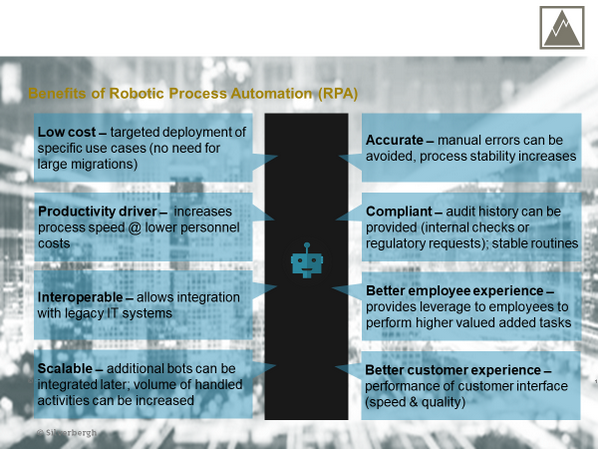
What to look for
Manual routines are still quite widespread across the trading process. Examples are
- M2M valuation of commodity stocks based on up to date inventories
- Creation of daily P&Ls and reconciliation of positions (volume & price grid)
- Trade confirmations & post-trade administration
- Reconciliation of payment data with contract data
- …
Additionally, reason for manual routines are e.g.
- Several legacy systems (e.g. CTRM, supply chain & storage, processing/ production, contract management)
- Unstructured data through communication by email, fax, phone etc.
If these characteristics are being observed, then digitizing some of these activities should be considered.
Reservations about digitization
At times there are reservations about digitizing initiatives and a bias to continue with legacy processes and routines.
- Costly larger scale migrations of ERP and CTRM (as experienced in the past)
- Additional burden on key personnel and as a result slippage of key commercial activities
- Operational risk (stalling operations)
- Loss of control (over automated routines and across the application lifecycle)
Each of the above reservations can be addressed by a well configured digitization approach.
- Legacy systems like ERP and CTRM can remain in place. Distinct and well-defined process routines can be automated by providing the link into existing systems
- The need to draw on internal personnel can be limited by avoiding larger scale migrations
- Individual process automations can be tested and even confirmed manually (if required). One can opt for the degree of automation vs. cooperation with automation routines being introduced.
- Complete visibility & transparency can be created by installing an integrated automation platform enabling
- full visibility of all automation routines established (Robotic Process Automation -RPA),
- processing status for each of the robots,
- linkage to data sources (as required) for manual reconciliation,
- digitization of unstructured data into manageable data formats (e.g. from fax to CSV),
- transparency on automation requests, use cases and automation requests throughout the organisation.
How to approach trading digitization
A couple of aspects should be kept in mind when considering automation:
- Identify & quantify automation opportunities
- Evaluate impact on company
- Improve to be automated process prior to automation
- Integrate execution of tasks conducted by humans and robots
- Track end-to-end process performance & integrate early warning signals in case of misperformance
- Continous administration of process architecture
- Continous improvement (and amendment of process architecture as required)
Additionally, technology selection should aim for a well respected and dynamic option. There are technology choices which are accepted in business environments with high security precautions and which have also been licensed by the US government.
Within a few weeks, automations use cases can be identified and implemented. Low hanging fruits should be pursued early on whereas automation opportunities with higher complexity might be pushed forward on the implementation agenda (e.g. image recognition).
If these considerations are kept in mind, financial performance will improve and the resilience of the business will increase.
Outlook
Automation opportunities in commodity trading are still not sufficiently leveraged. They are a key competitive factor going forward. From a cultural perspective, automation techniques match commodity trading organisations characteristics by providing lean and pragmatic access to productivity levers. There is no need to commit to large scale IT spending and hope for monetization in later years.
Infrastructure (3/2019) - REPRINT: The Future of Transportation - EXECUTIVE BRIEFING 2019
Funding games - digital technology in mobility
New mobility concepts are spreading. Some are driven by venture-funded start-ups; others are pursued by incumbents investigating new routes to market. So far, digital technology has played a pivotal role in helping to raise venture capital for typically asset-light platform businesses with the ability to scale quickly. Going forward, more asset investments are required to take mobility business models mainstream. This requires funding, and even though asset-light business models will continue to exist, asset owners need to be rewarded. Can digital technology support securing funding or is it a hurdle for future funding?
(COMPLETE ARTICLE: PLEASE DOWNLOAD BY CLICKING ON THE LINK TO THE RIGHT)
Klima-Transformation (2/2019)
Klimanotstand ... Was nun?
(Climate emergency ... How to manage?)
Verschiedene öffentliche Körperschaften - Regionen und Kommunen – rufen den Klimanotstand aus. Verwaltungen sind daher beauftragt, diesem neuen Politikfeld Rechnung zu tragen, es mit anderen Politikfeldern in Einklang zu bringen und es zum Bestandteil des täglichen Handelns zu machen. Ebenfalls wird der Nachweis zu erbringen sein, dass Emissionen reduziert worden sind. Ein dezidierter Management-Ansatz ist deshalb unerlässlich.
«Think global, act local …»
Der Klimawandel hat nun das Handeln auf der regionalen und kommunalen Ebene erreicht. Einzelne Klima-Massnahmen sind nicht mehr ausreichend. Vielmehr fordert die politische Willensbildung, dass ein strukturierter Ansatz verfolgt wird, indem regionale bzw. kommunale Aktivitäten auf ihre Klimaauswirkungen zu untersuchen sind.
Während der politische Auftrag klar ist, ist die Implementierung komplexer.
- Ganzheitliche Betrachtung ̶ Die derzeitige Debatte konzentriert sich auf CO2-Emissionen. Es ist jedoch zu beachten, dass es auch andere Emissionstypen gibt, die nicht zu vernachlässigen sind. Dies hat die Debatte um Feinstaub-, NOx und Lärmemissionen verdeutlicht.
- Wahl der Handlungsfelder ̶ Vor dem Hintergrund von Effektivitäts- und Effizienzabwägungen sind die Handlungsfelder auszuwählen, die zum einen beeinflussbar sind, und die es erlauben, Emissionen zeitnah beeinflussen zu können.
- Ex-ante vs. ex-post-Steuerung ̶ Einige Entscheide zum Klimanotstand sind derart formuliert, dass Massnahmen auf ihre Klimaauswirkungen hin zu untersuchen seien. Es handelt sich somit um eine ex-post Betrachtung. Die Frage ist, wie ex-ante Klimaanforderungen in den Steuerungsansatz integriert werden können, um somit die Ergebnisqualität zu verbessern.
- Ressourcenallokation ̶ Der politische Auftrag ist in der Regel sowohl innerhalb eines definierten Personaltableau als auch innerhalb bestehender Haushaltsrichtlinien zu bewerkstelligen.
- Erfolgsnachweis ̶ Die Verwaltung ist politische Instanzen gegenüber nachweispflichtig. Insofern ist zu empfehlen, im Zuge der Entwicklung von Klimareduktionsmassnahmen auch ein Klima-Controlling zu etablieren. Hier ist zu entscheiden, wie gegenüber einem Bezugspunkt mit Veränderungen umzugehen ist z.B. Veränderung des Leistungsspektrum der Kommune (Infrastruktur, Ausbau ÖPNV, …) oder etwas Bevölkerungswachstum (-rückgang).
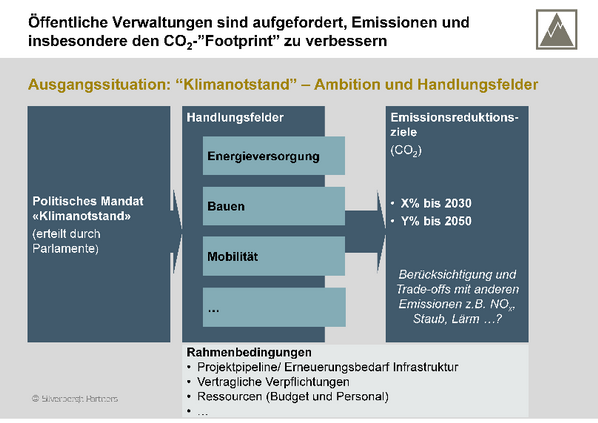
Für diese Themenkomplexe sind Antworten und Herangehensweisen zu entwickeln.
«Bang for the buck»
Jede Klimamassnahme hat Budget-Implikationen. Gäbe es keinen Haushaltsdeckel, könnten alle Massnahmen verfolgt werden.
Da dies jedoch nicht der Fall ist, ist es nicht nur aus haushalts- sondern auch aus klimapolitischen Erwägungen her geboten, die gegebenen Mittel möglichst effizient einzusetzen. Zieht man die CO2-Vermeidungskosten als Referenz hinzu, ist bei gegebenem Budget beispielsweise mit baulichen Sanierungs-Massnahmen eine grössere CO2-Reduktions zu erreichen als mit dem Neubau eines konventionellen Kraftwerkes.
CO2-Reduktionsmassnahmen sollten daher nicht ad hoc sondern über einen längeren Zeitraum geplant werden. Massnahmenbündel sollten dann bezüglich ihrer CO2-Vermeidungsleistung sowie ihrer Budgetimplikationen bewertet werden. Grundlage für die Massnahmenentwicklung müsste aber zunächst eine «long list» von möglichen Massnahmen sein.
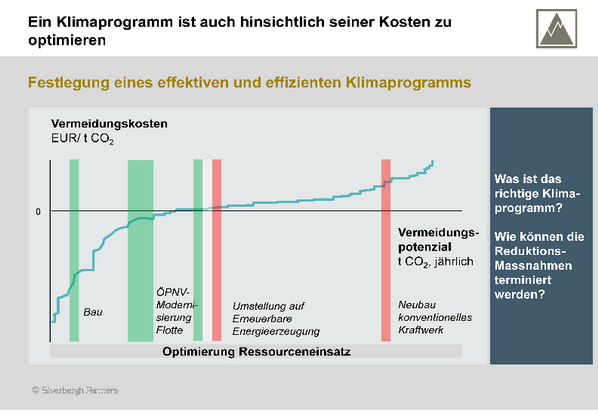
Für diese wären folgende Elemente zu klären.
- Meilensteine: z.B. Start- und Endpunkt der Realisierung
- CO2-Vermeidungseinfluss: Wann ist mit dem CO2-Vermeidungseinfluss zu rechnen? Für wie viele Jahre kann dieser angenommen werden?
- Budgeteinfluss: Was ist an Haushaltsmitteln für die Realisierung der Massnahme zu veranschlagen? Welche Personal-Ressourcen würden gebunden?
Wie steuern? Der Chief Climate Officer …
Es ist evident, dass die aus dem politischen Auftrag erwachsenden Ausgaben nicht «mal eben so» von der Verwaltung übernommen werden können. Die Festlegung einer expliziten Verantwortlichkeit und Rolle ist erforderlich, um alle Klimabelange zu bündeln und über Schnittstellen hinweg Erfolg gewährleisten zu können.
Die Verantwortlichkeit des Chief Climate Officers (CCO) umfasst die Übersetzung des politischen Auftrags in Zielvorgaben, die Analyse des Emissions-Footprint und des Einflusses von Einzelmassnahmen sowie deren Zusammenfassung in einem Klimaprogramm.
Dieses ist zwischen den verschiedenen Ressorts (Bau, Verkehr, Immobilienverwaltung, Energie etc.) abzustimmen insbesondere aber auch mit dem Finanzbereich.
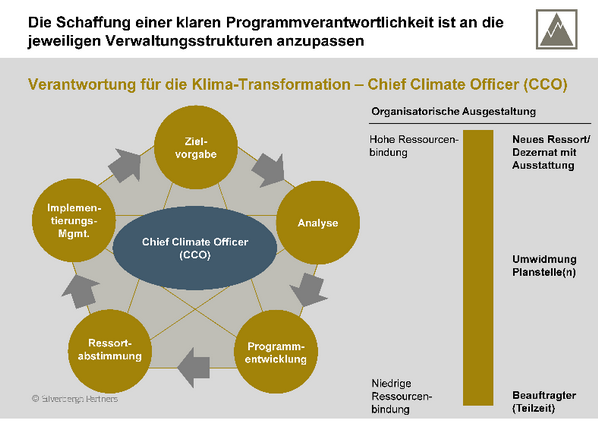
Ebenso ist ein Implementierungsmanagement aufzusetzen. Darunter sind verschieden Aspekte zu bündeln:
- Implementierungsverantwortlichkeiten, Zeitplan und Meilensteine
- Implementierungs-Controlling – sachliche Realisierung
- Impact-Controlling – Nachhalten der Emissionsreduktionen und Einpflegen in die Klimabilanz
- Finanz-Controlling – Nachhalten von Budgeteffekten
Wie der CCO in die Organisation eingebunden ist und wie dieser auszustatten ist, ist von den jeweiligen Gegebenheiten abhängig. Einflussfaktoren sind etwa Grösse der Region, Umfang des Auftrags bzw. des zu erwartenden Klimaprograms. Der CCO kann an eine bestehende Organisationseinheit (z.B. Umwelt oder Finanzen) angekoppelt werden bzw. neu als Organisationseinheit geschaffen werden. Mögliche Ausgestaltungsformen sind zu bewerten.
Implementierung eines nachhaltigen Klimaprogramms
Zur Entwicklung eines «Climate Improvement Programs (CIP)» kann in der Regel auf bereits bestehende Arbeiten zurückgegriffen werden. Dazu gehören u.a. die Erhebung des CO2-Footprints bzw. bereits erarbeitet Ökobilanzierungen sowie individuelle Klimamassnahmen (z.B. Modernisierung Busflotte durch Hybride, Bau von dezentralen Energieversorgungeinrichtungen wie BHKW und Solarkraftwerken, Wärmesanierung Schulen/ Verwaltungsgebäude). Insbesondere bei den teilnehmenden Kommunen am «Masterplan 100% Klimaschutz» sind umfängliche Arbeiten bereits erfolgt.
Die Bearbeitung von einzelnen Klimamassnahmen erfolgt in den verschiedenen Ressorts, sollte aber beim CCO als Gesamtverantwortlichen bzw. Projektverantwortlichen zusammenlaufen. Vor der Detaillierung von Einzelmassnahmen empfiehlt es sich, eine Gesamtreduktionserwartung zu etablieren und auf die einzelnen Ressorts herunterzubrechen. Auch wenn das CIP vom CCO verantwortlich geführt wird, ist aufgrund vieler Schnittstellenthemen zu überlegen, einen Lenkungskreis aus den Bereichsverantwortlichen einzurichten, die die entwickelten Massnahmen verabschieden. Andernfalls ist mit einem grossen Implementierungsrisiko zu rechnen, weil die notwendige Verbindlichkeit fehlt.
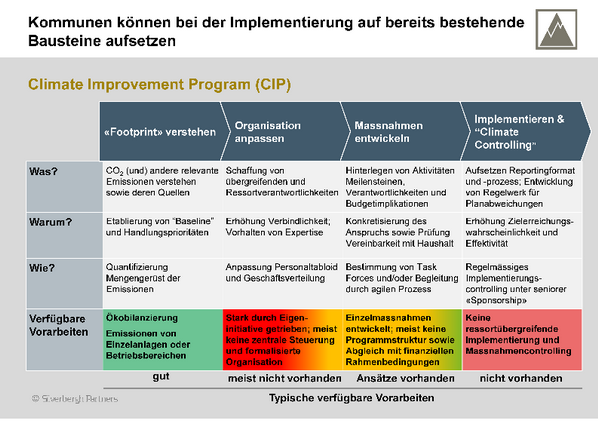
Ambitionen und Ergebnisse sind zu messen, bzw. wie oben beschrieben einem Controlling zu unterwerfen. Dies ist wiederum die Voraussetzung, offen und proaktiv kommunizieren zu können und die regionale Klimaagenda zu prägen und weiterzuentwickeln.
Bei der Festlegung des CIP sind die Charakteristiken alternativer CIP-Ausgestaltungen gegeneinander abzuwägen. Effizienz und Effektivitätserwägungen sind mit Budgetzielen in Einklang zu bringen. Ist diese Abwägung erfolgt, kommt das der Nachhaltigkeit des Programms zugute. Der Reduktionspfad ist spezifiziert. Die dafür erforderlichen Haushaltsmittel sind eingeplant. Soll-Ist-Abweichungen können im Controlling-Prozess identifiziert und adressiert werden.
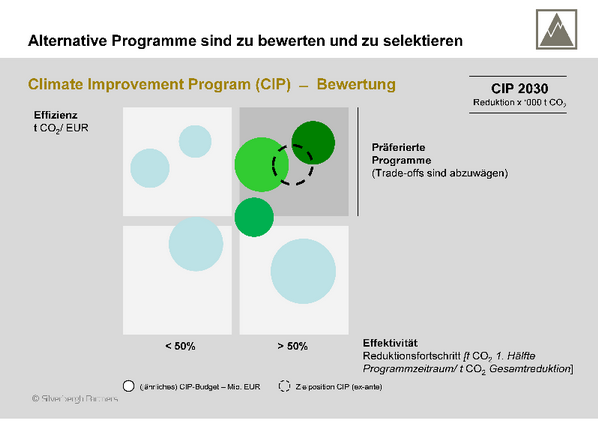
Ausblick
Das «Climate Improvement Program» ist eine hervorragende Möglichkeit, den Bürgerdialog zu prägen. Verwandte Leistungsangebote können besser kommuniziert werden. Auch kann das Verständnis über das Präferenzprofil des Bürgers geschärft werden, was wiederum in das CIP einfliessen kann. Gegebenenfalls können auch plebiszite Elemente zu wichtigen Richtungsentscheidungen eingeflochten werden.
In Summe kann das gemeinschaftliche regionale/lokale Bewusstsein gestärkt werden und ein Verständnis für Verwaltungshandeln gefördert werden, indem Klima-Massnahmen ein selbstverständlicher Teil politischen Handelns werden.
Commodity trading (1/2019)
Commodity trading value drivers 2019
Introduction
As we start into 2019, the hope is that the upcoming year will offer more trading opportunity than in the previous year. 2018 has been disappointing in terms of overall price development but did offer more trading opportunity by the end of the year. Can this positive sentiment be taken into 2019 and will it prevail throughout the year? What are the key value drivers to watch as the year matures?
Starting point
Looking back, some of the value drivers with a negative impact on trading activity and opoortunity we pointed out already in 2017 prevailed into the 2018 trading season incl. e.g. low volatility, narrow correlations, limited liquidity at the long tail. Overall after a good start in the beginning of the year, commodity prices contracted over the 2018 trading period. By the end of the year, volatility picked up attracting more capital. As such, some market participants contempleted to ramp up their trading activity. So, what can we expect from the 2019 trading season?
Trends to watch
In line with our overall value driver perception, we expect that political risks will play a more important role than in the past. Discontinuities in the political arena become more frequent and will leave their mark on trading markets. Will this be negative per se for trading activity? No, on the one hand, economic supply-demand fundamentals might be affected. On the other hand, this will also be a driver for volatility which creates trading opportunity. If this is captured and if market participants ‘play their hand successfully’, it will offer the opportunity to capitalize the existing trading activity and hence renew the ‘license to trade’. This is a challenge several commodity trading market participants intend to resolve in 2019.
Independent of supply-demand fundamentals in different asset classes, overarching patterns are important to understand as they may leave their mark on a single market. As several markets are globally traded and USD denominated, the role of the US and the state of the demand side are of utmost importance.
- Stimulating impact: From a global supply perspective, oil production increases. However contracting oil supply from individual suppliers e.g. Venezuela and Iran will contribute to higher prices. Additionally, the agreement of the OPEX+ countries to maintain the recently agreed quotas will add to price discipline. Spill over price effects into other commodity markets (e.g. softs and metals) might appear. Spiced with some geopolitical uncertainty e.g. LATAM, US-Russia-China and potentially new conflicts in Eastern Europe will add to price volatility. A weaker USD might also support stronger commodity prices. What would one have to believe in order to see this materializing? The US FED would need to keep interest rates at low levels (in order not to kill economic growth and put burden on the unemployment rate). Additionally, the US trade deficit would need to remain high without the possibility of a fast trade agreement e.g. with China (reducing the trade surplus). This stimulus can still take effect even though economic perspectives in China today are softer than expected last year. The Chinese economy slows down and order book effects in Chinas machinery industry can already be perceived.
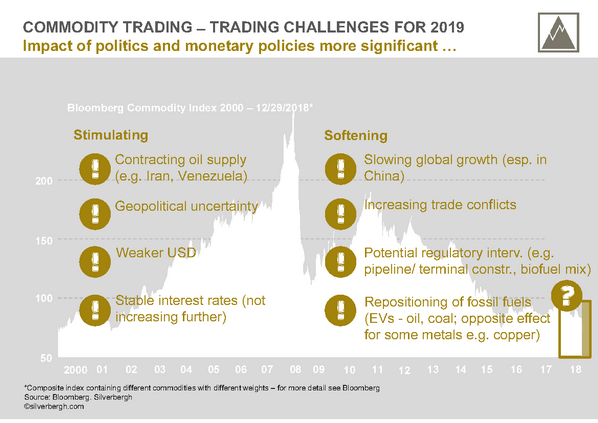
- Softening impact: Trading market conditions however might remain challenging if global growth slows further. This might be the case if e.g. China has to further correct growth numbers downwards during 2019. Brexit negotiations might stall adding more uncertainty to the transition process with the result of slower international trade and consumption. Unresolved trade conflicts or additional trade hurdles (tariff & non-tariff) would support this outcome. On individual commodities like gas, oil, coal or palm oil regulatory interventions, revised political objectives or amended technical specifications might put pressure on current price levels. Additionally, supply-demand balances of fossil fuels in the energy supply portfolio e.g. fuels, coal will be impacted as sales of electric vehicles (EVs) increase. Premium automotive manufactures will launch several models in 2019/20 and will start volume production. Also, the build out of renewables will continue in line with public policy objectives internationally. On the contrary as there is a potential softening impact of this development on fossil fuels, this would substantiate a continued stimulus for some metals e.g. copper.
Summary
What do we conclude? Challenges and opportunities are distributed slightly differently compared to the previous year. We perceive a riskier and more volatile politically induced economic macro environment. However, there are strong signs for somewhat attractive trading market conditions and prices in 2019. Some instability might create additional trading opportunity rather than destroy a positive market sentiment.
Outlook
For some market participants, 2019 will be an important year as they have to proof that they can create value and can attract capital for trading purposes.
Either trading performance will increase, or decisions will need to be taken to re-allocate economic capital and review the trading footprint. As a result, some trading activities might be closed, sold or partnerships might be considered. These decisions will also be driven by the evolution of cost-income ratios (CIR), margins (which are tight today), a decreasing capital base and challenging conditions to re-finance respectively capitalize.
International policy trends & value management implications (3/2018)
GLOBAL SOLUTIONS 2018 - THE WORLD POLICY FORUM: Impressions and learnings for the value management agenda
Key discussion topics and themes are being revisited. Trends and their relevance for corporate leaders and a company´s value management agenda are pointed out.
Introduction
Global Solutions is a format established by the German Government during the German G20 presidency in 2017. Research based policy advice is provided by a research and policy network (T20) to G20 leaders as they prepare for negotiations in Argentina (2018) and Japan (2019). The summit was hosted in Berlin and was attended by policy experts, government representatives, multinational organisations, corporates and NGOs. We provide some impressions on key discussion topics and themes which are of relevance for a company’s value management agenda.
Key trends discussed …
Across several works streams, forums and panel discussions some views were broadly shared. Key international policy trends described below are not entirely independent. However, they capture different aspects of the policy discussion today and provide angles how to identify risk exposure and risk mitigation.
- Multilateralism: The believe that ‘multilateralism’ is a key value of international relations is shrinking. Not only are perceived national interest in focus and isolationist policies spreading. Also, procedural standards, protocols and rituals in international relations are no longer taken as granted. Language and communication is eroding. This has a destabilizing effect and is a mounting hurdle to balance conflicting objectives of nations and policy stakeholders.
- Institutional stability: Institutions can provide a balance to evolving conflicts as they offer a well-established platform and formats which have been accepted by member states. From a a legal perspective, member states have entered into legal commitments. These commitments are binding and cannot be easily terminated unilaterally. However, several institutions have lost influence, are no longer effective as influential members have withdrawn their support. There are numerous examples. Almost all major international institutional frameworks or institutions are confronted with challenging questions regarding their legitimacy, validity or effectiveness: e.g. WTO, UN (and i.e. UNESCO), the NPT (Non-Proliferation Treaty) with Iran, the Kyoto Protocol, NATO, EU.
- International financial framework: It is already conventional wisdom that in the next financial crisis we will face a ‘lack of instruments given current fiscal and monetary policies (QE: quantitative easing)’. Additionally, some senior policy makers voice concerns that unlike in 2007/08 the mandate provided by the electorate to bail out financial institution last time will be lacking next time. This will also limit the solution space to cope with a next crisis.
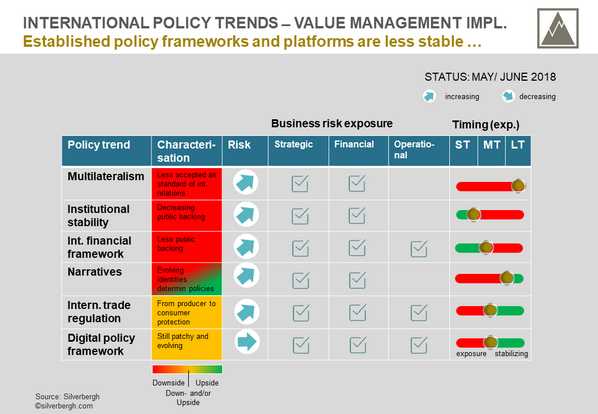
As a starting point for a potential crisis, mounting credit volumes esp. in the US were less of a concern. The instability of the Italian banking system combined with a lack of convincing regulation and sliding fiscal discipline worries a broad range of experts.
From as fiscal perspective, taxation frameworks need to change. Personal and corporate income taxes linked to traditional industrial activities as a share of total tax revenue are expected to decrease.
- Narratives: Narratives are slogans defining and describing the identity of social groups. There is wide spread agreement that these narratives are ‘increasingly influential and powerful’ changing identities, political realities and as a consequence policy frameworks. Nobel Prize laureate in Economics, Georg Akerlof, distinguished between ‘protector’ vs. ‘fulfilment narratives’. Examples of narratives are ‘Yes, we can …’, ‘America first’, or ‘Nobody cares about us’. These narratives evolve quickly and spread fast also due to digital communication. Not only politicians but also business leaders are directly affected and need to decide how to react to or proactively address these narratives.
- International trade regulation: Although recent events suggest that producer induced (protectionist) trade policies still rule trade policy making, the wide-spread opinion exists that this is changing. Consumer based trade policy regulation becomes more important. Recent examples are data privacy rulings or international trade agreements like the Transatlantic Trade and Investment Partnership (TTIP) which have been significantly influenced by consumer opinion.
- Digital policy framework: Surprisingly this has not really been a discussion topic during the summit. Other than data privacy which the EU recently regulated, and which impacts digital business models, policy stakeholders seem to struggle with understanding potential policy implications of ‘digital’.
As mentioned above briefly, the tax system will be affected. Other examples are standard processes in financial services, intellectual property rights exposed to additive manufacturing technologies e.g. 3D printing, security policies leveraging evolving digital security infrastructure and biometric information. In this area more work will be conducted.
… suggest a less stable international policy environment going forward …
The expectation is that across almost all international policy trends, volatility (of potential outcomes and impacts) is increasing.
For ‘digital policy framework’, experts are undecided how this will evolve. Hence, there is a perceived uncertainty.
If agreements would be reached this would a new baseline but not a risk. Therefore, for this policy scheme unlike as for the other policy schemes, risk perception remains unchanged.
… but with differening potential impact over time
Short- and long-term impact: Most importantly decreasing ‘multilateralism’ is already impacting international relations, economies and businesses today. The expectation is that this will also have long-term consequences on several policy areas. Businesses are exposed to several policy areas beyond trade policies.
Latent medium- to long-term impact: Some policy trends are widely discussed but have not exhibited broader short-term impacts yet. However, the assessment on their risk realizations varies from ‘respect’ to ‘fatalism’. ‘It is not a question that these risks will materialize it is more a question when this will happen …’. In this category are ‘Institutional stability’ and ‘International financial framework’.
Short-term risk with the potential to stabilize long-term: In this area are two policy trends. ‘International trade regulation’ is a key trend for which almost on a weekly basis risk realization can be perceived. Knock-on effects between different stakeholders and across different policy areas (outside trade policies) lead to a challenging situation framing and evaluating the risk. The hope remains that stability can be reached. A ‘new equilibrium’ however might look different from today´s situation. New alliances of stakeholders, new policy frameworks and new institutions might evolve over time most likely in the context of new geopolitical realities and security frameworks.
‘Digital policy framework’ is associated with risks as not much has been agreed to date (e.g. cross-border autonomous mobility). If, however ‘digital’ becomes more a reality framed as policies rather than a concept the expectation is that risk perception will decrease.
Outlook
In the recent past, some industries have experienced already quite some realization of these risks within the key policy schemes mentioned above. Industries most impacted are e.g. financial services, commodities, agriculture, manufacturing/ automotive.
Some of the above-mentioned sectors can adjust in some areas. But that takes time and comes at a cost. They have faced immediate revenue losses (but also increases) as a result of international policy conflicts and adjustments.
If infrastructure sectors or long-term infrastructure like investments are impacted, corrections ‘after the fact’ are even more expensive and much more difficult to achieve.
Therefore, it is important to realize that the nature of international relations is changing and that businesses must cope with this new reality. As the ‘new normal’ will be less stable, businesses are well advised to take a more active role to integrate international policy induced volatility into their business rationales.
This might imply, adjusting the portfolio mix of businesses or recalibrating an international value chain and manufacturing footprint.
Supporting activities might also be considered e.g. operational risk mitigation, hedging or forward sales, tighter cash flow management and treasury as well as targeted insurance protection (e.g. for exports).
REPRINT: The Future of Transportation - EXECUTIVE BRIEFING 2018 (2/2018)
The evolution of SMART transportation infrastructure
The digitization of the transportation sector will result in more comfort, convenience, and safety to users. On the other hand, stakes for EPC contractors, operators, and investors are rising. SMART transportation infrastructure relies on digital business models which are explorative and potentially volatile. Different types of operating models are being explored. The use of electronics and software implies new maintenance requirements and costs. The regulatory framework is not set yet but is evolving over time. Managing risk and volatility of this new asset class is central to future success. If this is achieved, additional private financing will be made available, closing today´s funding gap.
(COMPLETE ARTICLE: PLEASE DOWNLOAD BY CLICKING ON THE LINK TO THE RIGHT)
Raw materials sourcing (1/2018)
Increasing bottom line contribution …
Raw materials sourcing of FMCG/CPG companies, and in particular soft commodities sourcing has been challenged by market conditions. Price volatility has been high, financial markets have been somewhat illiquid complicating hedging activities. Accounting guidelines have been restrictive.
Sourcing practices are advancing, and markets continue to mature. Hence, it could be worthwhile to review raw material procurement program and close potential value leakages.
Performance pressure is increasing
FMCG and CPG companies are under increasing pressure. It is much harder to ensure top line growth and profitability compared to previous years.
- Market conditions are becoming fiercer and premiums of branded goods are under pressure
- Portfolio restructuring takes time and comes at a cost
- Digital transformation requires management attention
- The creation of online channels is difficult; some firms struggle to implement them successfully
- …
These are some of the reasons which are frequently being discussed.
For several FMCG and CPG firms’ raw materials and especially soft commodities are an important cost component. Could raw materials sourcing contribute more strongly to bottom line profitability?
Today, value leakage in commodity sourcing is significant
In several firms physical procurement rationales dominate commodities sourcing practices. Some markets have however developed into traded markets with significant volatility. Additionally, several markets are USD denominated and hence add currency exposure. Financial markets are not as developed as the underlying physical markets. Therefore, financial hedging opportunities are limited.
The influence on company profitability can be significant. A key issue is also a lack of synchronization between sales, manufacturing and sourcing. This is influenced by different dynamics in raw materials markets and product markets.
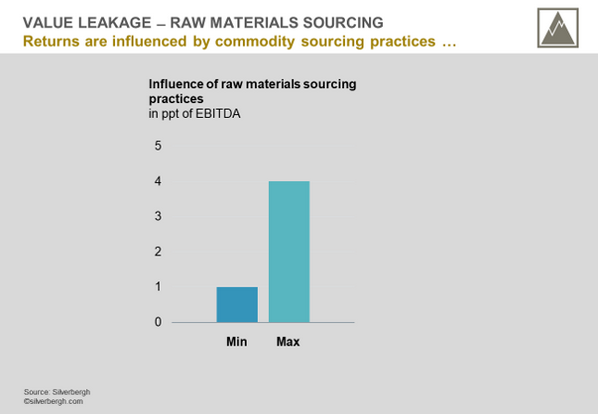
How can these differences be bridged and how can an agile organisation contribute to make amendments to the system to deal with e.g. seasonality, weather influences, competitive pressure, changing demand patterns?
Procurement practices are being upgraded
Companies are exploring a broad range of value levers to improve bottom-line profitability. In this effort, commodity sourcing practices are moving into the focus. A few value levers companies experiment with are …
- Hiring of commodity traders to manage commodity procurement operations
- Accounting treatment of hedges (in IFRS and FASB)
- Timing of shipments
- Market timing respectively over- and under-hedging to contribute profitability
- …
Strengthening raw materials procurement practices …
Some of the above activities might be justified. Experience shows that in some instances isolated initiatives could backfire and achieve the opposite. In this case the value leakage increases.
It is very important that the procurement activities are closely integrated into the company’s overall financial and operating framework. In several companies this integration can be improved.
It needs to be ensured that there is clarity of the respective value levers and roles and responsibilities to manage these value levers.
The raw materials value management framework guides the review of current practices as well as the comparison with adequate practices of other organisations. A comparison would also need to reflect the business model employed. Otherwise any comparison would be flawed and would lead to misinterpretations.
The business model is embedded into a strategic rationale which is assigned to raw materials procurement.
- According to which pattern is the procurement function supposed to source volumes?
- Which degrees of freedom to amend/ change procurement volumes and patterns exist?
- How is the procurement functions performance being measured and assessed?
- Which functions interfere with procurement activities?
- …
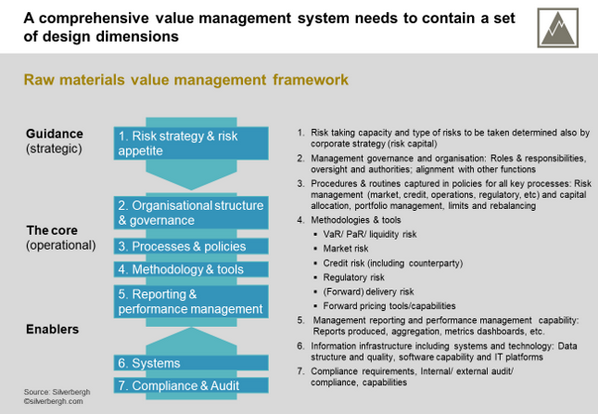
… will contribute to higher company earnings and enterprise value
Strengthening the raw materials functions set up will improve bottom line profitability and stability of earnings. A more sustainable company performance will directly translate into a higher enterprise value.
Coal marketing & trading (5/2017)
Metallurgical coal: 'From Dusk Till Dawn ...'
A few pressing questions are evolving after a period of low met coal prices and recent price spikes: ‘How will tomorrow`s met coal prices develop? What will be the key drivers for future prices?’ This report discusses a market outlook into 2021. Potential implications for market participants are explored.
This report investigates the price development in the metallurgical coking coal market. It details the key levers for this development and assesses the likelihood of future development. The evolution of the met coal market is expressed in some distinct scenarios, with the underlying drivers for the respective developments discussed. Implications for different groups of market participants are highlighted as well.
The report is based on the analysis of future supply-demand economics and the behaviour of market participants. The evolution of physical and financial wholesale and trading markets has been assessed in the context of the past evolution of other commodity wholesale and trading markets. Expectations of market participants and their view of the evolution of met coal markets have been reflected in this assessment.
In previous years, met coal prices have softened …
Met coal prices have been decreasing for quite some time.
- Before 2014: Price spikes of more than USD 300/t could be perceived (Q2/2011)
- Early 2014: Prices decreased below USD 150/t (PLV, FOB Australia) coming down from more than USD 200/t
- Q2/2015: Prices decreased below USD 100/t, staying below that mark for about 12 months
There has been a correlation between iron ore prices and met coal prices. Iron ore demand has been growing driving met coal demand but the demand growth rate has been declining. In 2014, demand started to plateau due to stabilizing demand in Asia. This had an impact on met coal prices. Met coal prices consolidated. Given declining profitability in the mining sector, mining companies started to reduce met coal production capacity. As a result, production economics of the intramarginal mines stabilized.
… but more recently prices have recovered …
Before 2016, marginal costs of production had been in the USD 130/t range. As mining companies restructured, high cost US met coal production capacities diminished. Therefore, the supply curve flattened. Marginal costs of production went down to USD 100/t.
However, supply constraints caused price increases. Chinese domestic production stalled. Logistics bottlenecks occurred and Australia faced production shortages as weather-related events lead to termination of some operations.
- Q2 2016: Prices increased continuously above USD 100/t and above USD 150/t in Q3/2016
- Q1/2017: Prices increased to more than USD 300/t. As such, it took 6 years to reach the same price levels as in Q2/2011
This is a very attractive price environment for producers and steel mills with integrated mining and steel positions.
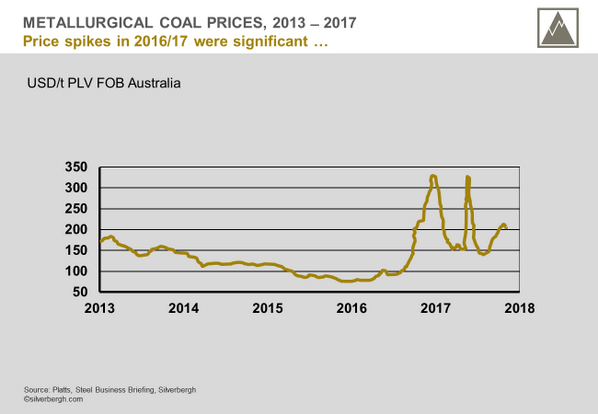
… and have started to decline again
Since then prices have been declining. In September 2017, prices (PLV, FOB Australia) were still above USD 200/t. Prices CFR China dropped below USD 200/t.
Market participants are concerned about the future price environment and market conduct
Market participants are increasingly concerned with the market outlook. Depending on how prices are expected to evolve, strategic decisions about future positioning in the market are impacted.
- Ownership in production capacity ̶ expansion vs. closure vs. acquisitions of equity coal positions
- Establishment of marketing contracts and offtake agreements
- Pricing of steel as input costs might change
- Build-out of trading activity for prop trading and hedging activities
In the physical market, the demand side will gain importance
Unlike in the recent past, the market equilibrium will be increasingly influenced by demand side developments as supply constraints are removed. Future price evolutions can be expressed in scenarios characterized by underlying assumptions.
- Base case: In this scenario, the supply-demand balance is stable. This is a solid basis for profit generation of miners.
- Supply side: Australian production will recover. Supply constraints in China will be removed. After the 19th National Party Congress in October 2017, supply constraints will most likely be confirmed (but balanced in order to avoid GDP impact).
- Demand side: Structurally, the demand composition will not change and demand will continue to grow.
- Assessment: LIKELY ̶ Short-term, this scenario is in line with financial market expectations. Longer-term, the scenario is less certain and will depend on the evolution of monetary policies and the economic health of the global economy.
- Low case: In this case, high prices today will stimulate production. Mines will open, productivity will increase, and demand will start to contract.
- Supply side: Australian output will increase by more than 12 Mt by 2021. New supply sources will develop as planned, e.g. in Mozambique and Indonesia.
- Demand side: Chinese demand will be balanced. Demand for residential housing construction will be limited and shifted to support a further build-out of infrastructure developments. Indian import demand growth will slow.
- Assessment: SOMEWHAT LIKELY ̶ The supply side might expand more strongly as opportunities arise, which would be in line with market conduct as experienced in the past.
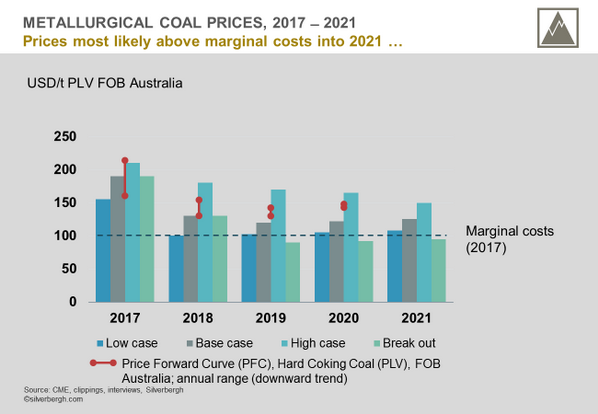
- High case: This case is characterized by overshooting prices as supply-demand will be out of balance.
- Supply: Chinese domestic supply will be significantly constrained. Australian production capacity additions will enter the market as planned. Domestic restrictions, met coal capacity additions and productivity increases will be more severe than anticipated today, e.g. labour. Today, total capacity additions are expected to be in the range 0f Mt 12 p.a. by 2021. They will not be reached. High cost US suppliers will increasingly act as swing suppliers as Australian production fails to meet demand.
- Demand: Longer-term demand will increase due to the following influences: Urbanization will increase and steel intensity of global GDP will decline less than expected. Steel intensity in China will increase, African steel demand will pick up. Modernization/relocation of Chinese steel mills will lead to higher seaborne import demand. Access to credit, especially in China and Japan, will remain unconstrained and hence construction activity will continue to grow.
- Assessment: LESS LIKELY ̶ The combination of significant supply and demand assumptions is probably less realistic.
- Break out: This scenario is in line with the base case into 2018. As of 2019, prices might drop below the marginal cost of production of about USD 100/t.
- Supply: Significant investments will be made and will foster additional supply. Productivity improvements will go beyond the expected rate. Australia will build out capacity beyond the Mt 12 p.a. by 2021. This would be more in line with productivity estimates around the 2014/15 timeframe. Mozambique will expand production beyond Mt 10 p.a. by 2021.
- Demand: Demand will be contracting induced by central bank policies, access to credit, and/or Chinese demand regulations, especially in process industries and electricity generation. This will also affect mining and steel manufacturing. Indian demand will increase but will stay below expectations.
- Assessment: SOMEWHAT LIKELY ̶ Quantitative easing (QE) of monetary policies of central banks is phasing out. Access to credit and exchange rates might be impacted within a five-year timeframe.
There are some other influencing factors on met coal demand which might gain relevance to the end of the forecast period or after 2021.
- Use of blast furnace vs. arc furnace (and use of scrap metal)
- Traditional blast furnace vs. pulverized coal injection (PCI) may lead to increased demand of soft coals. This would result in narrowing met coal price differentials (hard coals vs. soft coals)
- Demand substitution, e.g. in automotive (aluminium substituted by steel)
- Change in steel product mix, e.g. long vs. flat products (potentially influenced by Chinese regulation)
Across all scenarios, profitable production economics are expected
To summarize the evolution in the physical market, there are a few takeaways:
- Today´s high prices will not remain. Over time they will come down to reach significantly lower levels much more in line with historic prices.
- Prices will stay above marginal costs of production until 2018/19 in all market scenarios. Only in the ‘Break out’ scenario will prices drop slightly below marginal cost. Only price setting mines will be challenged to earn their variable costs. All other mines will generate profits and (part of their) capital costs of mine expansion and productivity, increasing investments. However, as the supply curve flattens, the inherent profitability of intramarginal mines should decrease (as the producer surplus decreases).
- Very low prices are not expected. In 2015/16 prices were significantly below USD 100/t. This situation is not expected to return.
- Price setting is expected to remain linked to spot prices. Although there are some efforts being made to squeeze out intermediaries, which in part has been successful, a broad return to quarterly contract prices is not expected. As prices have become transparent a fixed price regime would be associated with costs. A price differential between a fixed price contract and a spot market linked contract can be observed. The challenge with spot price linked contracts, however, is to deal with increased price volatility.
From today`s perspective, the next five years are expected to exhibit a higher and more stable price environment compared to the previous five years.
Financial markets are developing
Financial markets are developing. The Chicago Mercantile Exchange (CME) as well as the Singapore Exchange (SGX) are quite active in met coal trading and offer a range of products. SGX just recently launched an options market. Over the counter markets (OTC) have become more liquid.
Chinese traded paper markets, however, have consolidated over time. They are significantly influenced by the inflow of speculative capital. Volatility is significant, owing to speculation and still limited daily trading volumes. This is a burden for price discovery and hence will prohibit a healthy accumulation of market liquidity, as forward sales and hedging activity are hindered. However, speculation is not a problem per se. Once there is more market liquidity and decreasing influence of speculation on market prices, speculators will contribute to robust market conditions as they provide additional liquidity and facilitate risk transfers.
Market participants might want to review their positioning to capture upside
Every market participant might want to establish a view how he is potentially impacted by future market conditions. He might also explore the evolving opportunity space.
- Mining houses: Should the mining portfolio be reconfigured? How much capital should be devoted to mining extensions and greenfield developments vs. exploitation of existing brownfield operations? Should more flexibility be built into the portfolio to better cope with future price fluctuations? How can miners offer steel mills price stability and what would be the business case associated with this?
- Traders: How should met coal offtake agreements be negotiated? How should some of these met coal positions be sold-off into the market by providing price stability to met coal consumers and at the same time monetizing today’s high prices? How should cross-commodity plays be built out?
- Steel mills: How should met coal (and iron ore) be bought going forward? How should the commodity volatility be managed? How should financial hedging vs. other mitigation techniques be applied?
- Professional investors: Is this an opportunity to seek more met coal (and iron ore) exposure? If so, what would be the right mix of financial instruments, e.g. equity investments? Should individual investment opportunities or portfolio choices be revisited?
As several market participants have a positive perspective about the future market evolution they are already addressing some of the above questions. There are still opportunities to be captured but positions are already being taken.
Blockchain SPECIAL
The evolution of 2nd generation crypto currencies
Crypto currencies (CC) are attracting increasing attention not only as payment instruments but also more recently as an investment asset class. The underlying blockchain technology is moving into the mainstream enabling payment processes, efficient operating processes and identification procedures. Hence, it is expected that for future transfer of financial assets, blockchain, and more specifically CCs, will gain significant importance. On the contrary however, doubts have been voiced more explicitly that given some structural deficiencies, crypto currencies fall short of traditional currencies and will not prevail as such. Therefore, they may not substitute or even complement traditional currencies on a larger scale.
In this article, we will investigate the deficiencies of CCs today. Functionalities of traditional currencies are being revisited and discussed whether they apply to CCs as well. Some suggestions will be provided how CCs could be further developed into more widely used ‘currencies’. As such, CCs might become more competitive and relevant and as a result gain market share as a means of payment, as a store of value and as an investment asset class.
(COMPLETE ARTICLE: PLEASE DOWNLOAD BY CLICKING ON THE LINK TO THE RIGHT)
P2P energy networks (4/2017)
A win-win-situation to be monetized
These days, distributed energy solutions are very much discussed from a technical angle. They however have the potential to be the foundation for new business models and to take commercial customer relationships to new levels. We might see a closer integration of the energy industry with the financial services industry. For every market participant, there are significant potential gains in this development. It needs to be seen who will take the lead – incumbents, new entrants, investors or regulators.
The energy market is still in a crisis mode. However, investments into distributed energy generation are expected to be in the range of USD 200-300 BN per annum. Until now a centralized energy landscape has prevailed. Going forward, a more decentralized energy system might be a way out of today’s energy dilemma.
Different stakeholders would benefit from this development and some arguments will be presented why this would be the case.
- Customers: Attractive, stable energy costs and a sustainable energy supply
- Utilities: New solution business with attractive margin potential for incumbents as well as new entrants
- Investors: New infrastructure like investment opportunities
- Regulators: A more stable energy supply system
A more favourable market environment for decentralised energy solutions …
Decentralized energy solutions do exist for quite a while. In some markets e.g. Germany solar has become a quite sizable segment. New business models are evolving attracting significant investments e.g. Tesla, Northvolt, Vattenfall/ BMW i3 batteries …
This time, there are several reasons why decentralized energy solutions might take off and scale.
- Grid parity has been reached as several renewable technologies have industrialized and are competitive from a cost perspective
- Price spreads have narrowed significantly erasing fundamental margin potential for conventional centralized generation in wholesale markets (spark & dark spreads, location spreads, base/peak spreads)
- Traditional generation has aged, is phasing out or is already scheduled for phase out (nuclear)
- Large scale renewables projects or regulated midstream investment opportunities are less available
Additionally, new technologies are maturing and are becoming financially relevant.
… and an accelerated technology development
From a centralized perspective, efforts have been underway to flex the energy system (e.g. gas-to-power). Flexibility in wholesale contracts has been very much exploited. Demand side management in retail markets has however not been very effective.
In the last few years’ efficient energy technologies have become commercially available also to end users (e.g. heating, CHP, solar). Additionally, communication interfaces are being deployed through SMART meters enabling customer specific communication and pricing.
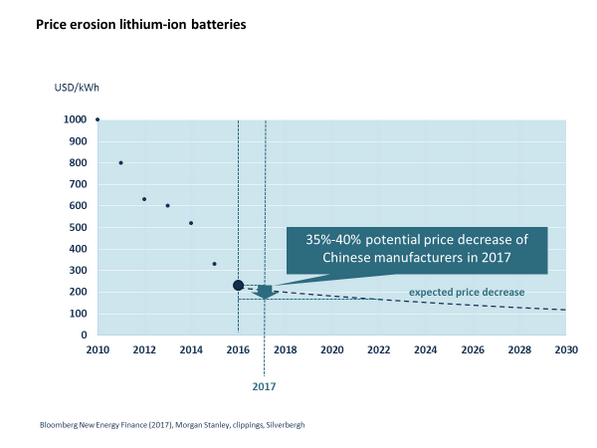
Sufficient electricity storage capacity is still missing which would allow the balancing of increasing volatility from renewables (esp. wind but also solar). As battery prices are coming down also due to the evolution of e-mobility, more efficient decentralized energy solutions will become available to SME´s and retail customers. In 2017 an accelerated cost down of battery costs of another 35-40% driven by Chinese manufacturers is expected.
2nd generation decentralized solutions providers will reach profitability
The 1st generation of decentralized solutions providers was very much hardware driven. With further technology development, their business case will become more compelling.
A 2nd generation of decentralized solutions providers has entered the scene. Beyond the hardware aspect they include other elements into their business model e.g. stronger operating expertise, financing, payment systems and/or peer-to-peer energy networks (P2P). The latter aims to balance deviating supply and demand patterns across the system. Settlement of imbalances might happen physically or financially. This constitutes decentralized market design.
Through technology, energy P2P networks might integrate with other P2P markets as well as with centrally organized wholesale markets. Each arrangement or structure will fulfil certain roles e.g. identification or market participants, administration of contracts, price discovery, settlement.
Dezentralied market design evolves across different sectors
In wholesale energy markets as in capital markets, market operators and exchanges are consolidating. Major drivers are economies of scale and characteristics of natural monopolies. In some of these markets, market operators have started to experiment with technologies allowing them to identify market participants better and to administer trades more effectively and efficiently. Blockchain is being tested as a lever to improve effectiveness and efficiency and as one element of a future P2P energy solution.
In payments, also blockchain based approaches have been established.
E-mobility markets will be at the interface between mobility, energy and financial services. Payment solutions are required to also charge cars and to determine the identity of the user. As electric cars will not only withdraw electricity from the grid but also feedback into the grid at a later stage, SMART grid capabilities will evolve. In this new environment, the market rationale will transition from a technically dominated perspective of supply sources and demand sinks towards a user/customer centric perspective. Contributing to a balance/ imbalance in the system will be associated with a price and the customer will be priced/ rewarded accordingly. Today, some of the commercial mechanisms rely on statistical patterns (e.g. standardized load curves). In the future, grid interactions will be individualized in line with specific demand/supply patterns.
Some implementation hurdles remain
As we are still in the early stages of the development, some implementation hurdles remain but are being addressed already.
- Strategic ambition of incumbents: Incumbents are on their way to determine how to best balance legacy and new businesses. Some new businesses are not as profitable as the legacy business which leads to discussions whether new business models should be pursued.
- Grid tariffs: Traditional grid tariff designs have not been developed with the idea that P2P balancing would be possible or that individual demand/supply patterns might matter. Depending on which grid levels are being used, grid costs are still substantial. Grid operators and regulators are aware of the issue and investigate options to potentially amend grid codes. Further decreasing hardware prices might compensate this cost disadvantage.
- Payments: A common standard would be favourable – currently, this is being driven by the e-mobility sector. Once established, it could also be utilized in stationary energy solutions.
- Risk exposures: As more sizable implementation schemes have not been defined yet (given some of the implementation hurdles), risk exposures of such schemes have not been formalized. Once risks are identified, evaluated and formalized the investment case can be matched with a financing structure. If investor expectations are met, capital will be attracted.
As implementation hurdles are being removed, new value pools can be monetized.
Benefits for supply side market participants
- Incumbents: There is the opportunity to transform the customer relationship if a standard supply contract is being replaced by a solutions contract.
- There will be several margin components e.g. for hardware, financing, operations contract, backup power, broadband services …
- The customer relationships will be more sticky as short notice contract cancelations will be less likely to happen
- Upsell potentials for additional services might be investigated which are more dependent on customer insight, communication and financing offerings than just the supply of kWh or Joules.
- Entering the market with decentralized energy solutions and scaling these can also be viewed as a defensive move prohibiting new entrants to break into the traditional supply business and to gain market share.
- New entrants: A new business might be established as incumbents move slowly. Financing of the build out should be available if structured appropriately. In the past, hardware and ecosystem were significant entry barriers. Today, hardware is commercially available and competitiveness depends much more on which services are structured around the hardware. Experience from other sectors is therefore helpful to establish a customer value proposition e.g. telecom, finance, consumer goods.
- Investors: New infrastructure like investments in a more competitive infrastructure market are available. Utility balance sheets are constrained and do not allow sizable funding. Record high capital inflow into today´s infrastructure market leads to reducing expected returns on investment. Therefore, this might be a new and attractive segment. Why is this the case?
- It is in line with regulator ambitions to stimulate renewables build out.
- It is more attractive than competing projects with funding needs. E.g. charging stations for e-cars exhibit more complexity. Technical standards are not clear yet (type of battery system and age of battery), uncertain adoption of new infrastructure, strategic risk of competing infrastructure, vandalism, …). For decentralized (P2P) energy solutions, several risk and value drivers can be determined upfront. The hardware (e.g. PV with battery) is a cash generating asset (if there is a lease or a loan). Electricity prices can be defined upfront and hence there is no or limited outright or spread energy price exposure. Counterparty/ credit risk is highly diversified and in case there is a default the hardware could potentially be recovered.
- Regulators: This is a fully privately financed scheme which allows to replace some centralized generation capacity. Countries with aged or obsolete infrastructure would benefit most from adopting these schemes e.g. if there are high shares of old conventional generation (fossil and nuclear) or weak and congested grids.
The regulators might want to consider to which degree a new energy landscape is more stable and instrumental for the redistribution of externalities. Centralized generation (also renewables) exhibit some negative externalities (environmental damages, emissions, downstream infrastructure build out …). With the roll-out of decentralized units several externalities are being internalized. Also, the shut down costs would be cost neutral for the public. The question is whether this should be reflected in the regulatory framework resp. in an amended grid code providing more favourable conditions to decentralized units and/or decentralized (P2P) energy solutions.
Ambitions for a future market position need to be clarified
Now is the time to review the position each stakeholder aspires and will most likely have in the future energy landscape. Actions should be defined accordingly and aligned with the strategic and financial plan.
Innovation management (3/2017)
Digitalization vs. innovation management
Digitalization is one of the most frequently used business terms these days. But where will it take the company? Will it be better off at some time in the future or is it a gamble with an unclear outcome? Given the hype around some developments in the digital space, it is worth revisiting some of the developments and calibrating the approach to digitalization.
Digitalization is a key area of focus in many companies. Indeed, the speed of technology development is enormous and every day new technology businesses enter the scene. Let´s take a break and revisit this evolution.
- Importance of digital businesses created so far: As of today, 4 of the top 5 global companies in terms of market cap are digital companies – Apple, Alphabet, Microsoft and Amazon. Together they have a market cap of USD 2,2 TR. On the 6th rank Facebook follows with a market cap of USD 397 BN (1 March 2017).
- Investments into digitalization: As of 2019 USD 2.1 TR will be invested into digitalization (IDC)
As digital company market values soar, corporations launch digitalization strategies and drive individual digitalization initiatives forward. Without any doubt, several of these programs will deliver what they were tasked to achieve. Even if this is the case and targets set by senior management will be achieved, will the company be better off afterwards?
Some surveys draw the distinction between digital innovation leaders and their high profitability and digital laggards with low profitability. But how about the other companies which are neither leaders not laggards but which try to identify their approach to digital which is best suited for them?
Digitalization is not a goal but an enabler to achieve goals
A significant part of the digitalization discussion is flawed. It is not a goal to be digital but it should be a result of achieving a better value proposition for the customer and as a consequence enterprise value. Hence, numerous digitalization discussions start from a wrong departure point.
More fundamentally what really matters is the companies approach to innovation management and the innovations. The stakeholders are
- Customers: How does the company ensure a better customer value proposition and customer experience. This can be further broken down into contributing items and measured accordingly e.g. relative price, product/service quality, response time, lead time to delivery, lifecycle costs.
- Employees: How can corporate innovations enable and support the individual as well as organisational units to better contribute to the customer value proposition and improve the efficiency and effectiveness of the operating model.
The solution to some of these challenges is not necessarily a digital approach but might be one. Additionally, a digital solution might even facilitate a step change making a conventional solution or approach redundant.
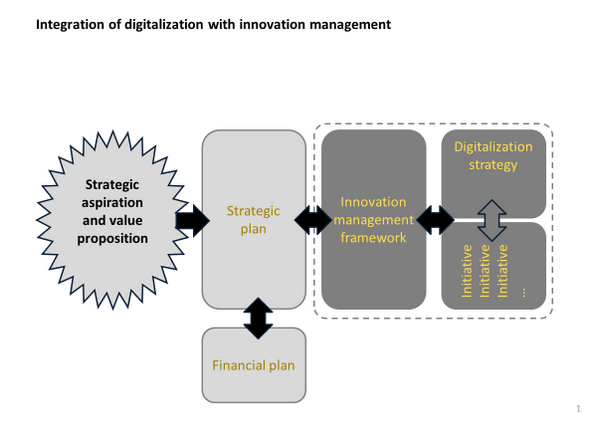
Innovating in a no-linear and non-deterministic market environment
It is important to understand that digital solutions need to be fit for purpose. These types of solutions will require iterations to have them established. Additional iterations are required to keep them up to date and in line with evolving requirements.
It would be a misconception to assume that senior management puts out an order and the organisation delivers.
On the other hand, there are companies which get involved with digital and which approach the topic very much with a linear top down thinking. What might be the setbacks? Initiatives might be created which can internally be sold as progress but which lack market traction as they miss out on an improved customer value proposition. What are examples of such programs?
- App creation: This nicely paints a picture of an innovative organisation. It is mainly used for communication purposes (which could also be done through other channels) and does not leverage technology for customer engagement
- Development of new proprietary technology environments: A new technology environment is established and ideally additional partners are signed on. The main line of thought is that ´the winner will take it all´. The customer could not care less – his main problem is not a lack of a technology environment but a lack of a common standard which jeopardizes the interoperability e.g. in IOT.
- In-house developments: In-house developments in a lot of cases take time and are costly. A `not invented-here syndrome´ is not uncommon. Being more pragmatic and rational to consider partnerships and acquisition to complement in-house initiatives would be a benefit for the innovation agenda.
Old-world linear top down thinking needs to be overcome. But how should that work?
Human interaction drives innovation
In order to innovate and potentially digitize and digitalize, (informal) human interaction is absolutely key. Solutions aspired are complex and cannot be fully specified upfront. But what are the ingredients for such a set up?
- Decide on fit for purpose organisational structure – Organisational structure and organisational conduct need to be determined up front. Is the innovation quite fundamental, a segregation from the legacy organisation should be contemplated. At a later stage, different organisational units could be integrated again. In case incremental or business process innovation is being pursued, this could take place in the legacy organisation.
- Create an innovation friendly culture – This is more easily said but much more difficult to achieve. Key is an interactive work environment and the ability to communicate freely vertically as well as horizontally.
- Enable risk taking and allow failure – Traditional organisations sanction failure and hence individual risk taking is undermined. To assume that innovation comes without risks and failure is another misconception. Failure needs to be possible. However, management obligation would be to establish a process which contains risk taking and defines an institutional approach how the organisation will learn from mistakes. In technology companies this is done through stage gating in R&D processes with clearly defined milestones linked to economic considerations.
- Link innovation goals to strategic aims of the company – Applying a lifecycle rationale to business activities allows to distinguish generically between three different type of businesses a) old contracting legacy business b) mature core business c) growing innovative business (with the expectation to significantly contribute to the future revenue stream). Especially b) and c) demand innovation. For a mature core business (b), process innovations are important to cash out over a long period of time. For a growing innovative business (c) a range of innovations is required – typically, product/ service innovation, manufacturing and production technology as well as go-to-market innovation and customer acquisition. In all these cases, digital solutions might help to improve on all the performance dimensions e.g. quality, costs and speed. For a growing innovative business, the degrees of freedom are significant and the opportunity exist to innovate the entire value chain.

Digitalization needs to be embedded into an innovation management approach
What are the learnings?
- Innovation management is risk and opportunity management typically in a risk averse corporate environment: As any other corporate activity, innovations need to take place in a given well defined budget framework. Within this budget, they need to deliver results. Earlier we discussed briefly how this is done by technology companies. In the start-up context Eric Ries (The Lean Startup) emphasises this aspect as well but uses a slightly different language. He talks about `innovation controlling` and the need to `pivot` once the innovation plan and innovation progress deviate. It means that new solutions need to be found to further progress the business and to avoid that the innovation and business building activity stalls.
- Digitalization initiatives need to be embedded into an innovation management approach: Digitalization is no substitute for a innovation management approach and vice versa. Digitalization should follow the innovation agenda which again is aligned with the strategic and financial plan. Additionally, digitalization is sometimes confused with digitization – both are quite similar terms but are not the same. Digitization stresses the technical aspects to move a business into the digital sphere, business dimensions are not really considered.
- Digitalization requires creativity which needs to be governed through the innovation management agenda and framework: Digitalization initiatives in some companies fall short of this requirement. Therefore, important aspects to make the digitalization initiative successful are not defined. Communication channels and cooperation models in the organisation are not defined. Conflicts of interest and incentives as set out in the performance management process prevail. This undermines human interaction which again is the basis for collaboration across organisational hurdles and fosters creativity.
Political risk (2/2017)
Coming to grips with political risk
In the past, the concept of political risk has been somewhat obscure. Applications with relevance for day-to-day management have not been entirely clear. However, political events in early 2017 have fuelled the conviction that political risk is entering the global agenda again. Risk management instruments as established in the past require sharpening and need to be integrated into management routine.
Political risk or geopolitical risk is of increasing concern. From a Western perspective, we have experienced peace and increasing wealth in recent decades. Political risk has been basically discussed in the context of developing countries. As such, this has been of limited practical relevance for day-to-day management. Shifting political preferences can be perceived in all global regions. Two major events have caused a debate which political risks we will need to face in the future.
- The European perspective – Brexit: The UK vote to leave the EU has come unexpected. There is a fear that in 2017 the EU might further disintegrate in the light of upcoming elections and fiscal instability.
- The US perspective – Presidential elections: The victory of the Republican candidate had not been expected by the polls.
The new president is not only rolling out his domestic agenda. Other global regions are learning that the new US administration continuously adds new TOPs to global agenda.
So, is this covered by today´s understanding what political risk is? Are the tools available to add political risk to the management agenda?
Well established political and country risk landscape
Yes, there are surveys and tools which capture political risks.
- Country risk ratings capture political risk on a country level. These are meant to inform investment decision making covering dimensions like legal stability, capital movements and default risk. These ratings provide little information about how businesses might be exposed to the evolving political risk and how these could be mitigated. Examples are e.g. Financial Times, Association for Financial Professionals, EIU, Euromoney, World Economic Forum.
- Risk inventory in companies covers some aspects of political risk but certainly not the dimensions of the evolving political risk landscape. Risks in the risk inventory typically follow a geographic structure. Some political risks in the general discussions are somewhat generic and are difficult to handle in a specific company context e.g. `failing states`, `armoured conflicts`.
But a new class of political risks is evolving which can be summarized as `decreasing political consent`.
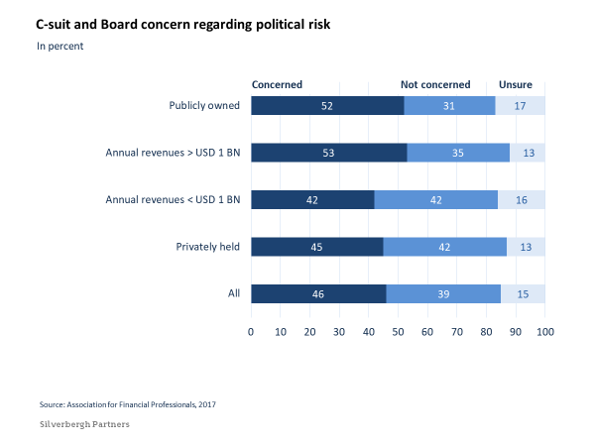
`Decreasing political consent` - the evolving political risk
In Europe, new evolving political movements can be observed. Public opinion is shifting away from established political players. Consequently, new alliances and priorities are possible. Although economic well-being has increased across the board, social and geographic disparities are mounting. The new US administration is putting established policy areas to the test. It is quite articulate about potential future policy changes.
- Global free trade – Free trade agreements are challenged and a revision of corporate taxes and customs regulation with the intention to foster domestic business activity are to be expected. The changes seem to be in line with the general WTO framework. However, the new trade policies might impact security frameworks e.g. in APAC the role of China. As a result, Europe as a trade partner for countries in the region might be elevated further.
- International security framework – not only the Transatlantic Alliance is being questioned. The new administration signals that it is willing to move away from the current frameworks in APAC and in the Middle East. These movements are paired with mixed signals threatening or appeasing rivals not ruling out sanctions or even interventions.
- Stability of foreign relations and multilateral political agreements – Foreign relations in NA are being redefined. The policy framework regarding Russia and the Middle East is not clear yet but seems to be patchy and volatile. Europe will be affected whatever this framework will look like. Current communications suggest that the role of the EU is viewed as an economic adversary rather than a construct which has secured peace in Europe for quite some time now. Separation from the union is being supported (e.g. the Brexit).
- Regulation of financial markets – The administration intends to review and change some of the financial market regulation which was created after the financial crisis. Indeed, there are good reasons to review the regulation and its effects. Concentration of large banks has increased – this is the opposite what was intended with the regulations. As small and medium sized banks have been shaken out, loans provided to SMEs have decreased. On the other hand, international consent how to regulate financial markets and how to create a level playing field might be at stake. The Brexit will also leave its mark on financial market regulation with still uncertain outcome.
In the US and in Europe, the reason for a changed for a policy mix is routed in an increasing economic disparity.
Although some of these policy goals are controversial, also agreement to challenge established policy frameworks across thriving new political forces across regions and across the Atlantic can be observed.
Because of a changing policy environment, political risk becomes more relevant.
In Europe, political risk has become more important as well. Different elections will take place in 2017. Most importantly presidential elections in France and Germany will influence how the EU will develop further. Elections in Hungary and in some SEE countries will determine how stable the union is at its borders. Given increasing East-West tensions this will also have security implications.
As the financial recovery of Greece does not develop as planned, the stability of Southern European countries is back on the agenda foremost Italy, Iberia and Cyprus. Immigration policies remain unaligned between the European partners.
The question is whether Europe will succeed to better form and execute common policy goals and hence strengthen the union or whether national interest will prevail increasing the likelihood of the union to further disintegrate.
Especially C-suit executives and boards are concerned that political risk might influence their financials significantly. Hence, they are convinced that their companies should prepare to mitigate political risks.
Observations on the evolving risk landscape
In early 2017 the signals are mixed. The expectation that a change of the US administration would send equity markets downward, has not materialized. Quite the opposite has happened. Additionally, since the election, equity market volatility is low. So, is the debate about political risk overheated? We would argue that it is not.
The short-term market effects are driven by announcements of low US taxes compared with targeted expansionist government spent in a low oil price market environment. These would also create a global stimulus.
On the other hand, policy effects driven by political dissent as described above and to a degree sympathized with by political forces across global regions might have a contracting effect according to the economic rule book.
One should also be reminded that risk is not just the downside risk but also a potential upside. Maybe this is what we observe in early 2017.
Implications for the risk management approach
Clearly, country risk ratings provide political risk information in a highly-aggregated form. As such, they are insufficient to provide guidance how to mitigate risks. They need to be complemented by some explicit understanding which allows to link company operations to the risk perspective.
In the case of changing political forces and regulatory interventions, political aspirations need to be broken down into policy areas.
A good understanding of the solution space and trending within given policy areas allows to take a much more pragmatic approach to political risk management. Potential outcomes and implications for the company can be assessed.
Impacts for the company can be linked to functional and business areas. Therefore, the financial impact of risk can be assessed.
- Example 1: Sales – How will new US customs regulations or an amended tax scheme influence the companies top and bottom line? Will it lose some of the export markets due to political instability? To which degree does local regulation facilitate or protect market access?
- Example 2: Global supply chain and manufacturing footprint – Are global supply chains stable? Are they exposed to geopolitical frictions? Will changing taxation require to restructure them?
- Example 3: Workforce – Will it be possible to continue to source the qualifications needed at an attractive price point?
- Example 4: IP – Is it possible to protect the property rights of the firm against private and public interference?
- Example 5: Currencies – To which degree will the company be affected by politically induced changes of exchange rates and the oil price? Can some trends be observed e.g. due to changes in monetary policies?
- Example 6: Cyber – Beyond traditional cyber risk, will increased cyber activity by governments and secret services face an increasing threat for my company operations and financial interests?
Some tangible actions can be initiated
What initiatives should companies pursue to better manage political risk?
- Build out political risk landscape: Get a better understanding about how political intentions might translate into policies. Build an expectation about how different political stakeholders might behave
- Prioritise expected policy changes regarding potential impact on company: Concentrate on risks which have a high likelihood and relevance to the company (e.g. alignment with geographic company footprint); schedule reviews for risks currently being deprioritized
- Update risk inventory: Integrate new type of risks into the company’s risk register and evaluate the risks (likelihood and impact). Potentially amend parameterization of risk which are already in the current register (e.g. increased exchange rate volatility, corrected assumptions on GDP growth and interest rates)
- Discuss mitigation actions: Make mitigation actions part of the ongoing risk discussion and performance dialogue. Assess the benefit of proactive defensive strategic moves (e.g. lobbying, communication, rebalancing of operations)
And … don´t forget to cover the upside of political risk
As the risk inventory is being updated not only the downsides of risk should be looked at. Potential opportunities should be considered as well. Here are some examples.
As mentioned before, recent political developments have stimulated capital markets. This stimulus might continue to exist if US companies get more traction and benefit from the announced policy goals.
Banking in NA will most likely face more beneficial conditions compared to the previous years. The Brexit is already causing the relocation of financial services businesses to other European geographies. The trade between China and Europe has been growing and is expected to grow further especially if the US policy position on China and some of the APAC countries remains. In case we would face a further disintegration of the EU, countries deciding to leave the union might become more attractive as locations for production. Production costs might decrease due to the devaluation of the local currency or fiscal policy changes (if bilateral trade agreements will still soften the burden of leaving the union). Today, this is not a very likely scenario because it contradicts the fundamental believes of the union.
However, the recent past has taught us that we live in a dynamic environment and that what seems unthinkable today should already be anticipated.
Infrastructure (1/2017)
Managing infrastructure investments
Capital markets continue to generate low and volatile returns. Therefore, institutional investors look for more opportunities to backfill their investment pipeline generating stable and attractive returns. Traditional regulated asset opportunities are limited and new opportunities need to be identified. On the other hand, strategic investors and the public sector are challenged to find new means of financing. New operating and partnership models to renew and expand public infrastructure need to be established. This is a win-win for both market sides if volatility and project risks are contained and stable financial results are achieved.
Infrastructure investment needs in the OECD are estimated to be in the range of USD 71 TR (3.5% of GDP) until 2030. This offers opportunities for strategic and institutional investors.
- Strategic investors: There is opportunity to participate in asset investments. However, these types of investments have exhibited significant risks which have been underestimated. Only to some degree these risks have been addressed in contractual structures.
- Financial investors: In the broader investment community, there is still the believe that all infrastructure assets exhibit ‘more or less’ stable risk profiles. Unfortunately, this is not the case. There are very distinct asset risks as well as fundamental differences in the composition of market vs. political/ regulatory risk depending on the infrastructure asset class.
Some of these risks materialize already in the construction phase.
Cost overruns in infrastructure are substantial
An analysis of more than 1600 infrastructure projects reveals, that cost overruns in the construction phase are substantial.
- Dams is the asset class with the most significant cost overruns.
- Transportation network infrastructure with rail and BRT shows cost overruns to be at around 40% whereas roads score slightly better with overruns of about 24%.
- Individual infrastructure projects finish the construction phase on average with a 30-40% cost overrun.
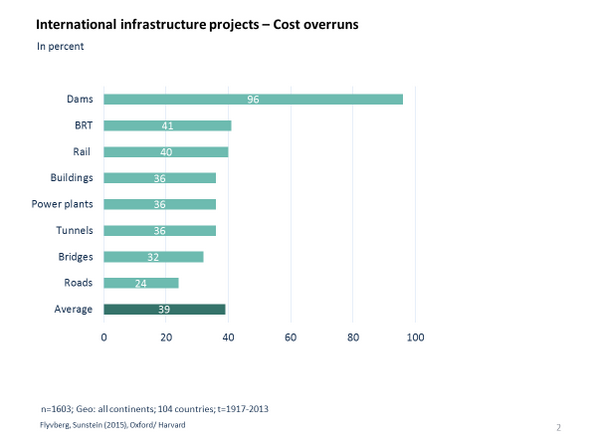
These figures show that infrastructure projects face a significant NPV impact from the very start. Taking them into a profitability zone during the asset lifecycle is quite challenging. Recent infrastructure projects could be quoted which finished the construction phase with cost overruns being multiples of the initially budgeted construction costs.
What are other typical pitfalls which can be observed with infrastructure projects?
Typical pitfalls in infrastructure projects
Reviewing infrastructure projects which are currently in the planning and construction phase surfaces typical pitfalls
- Governance structure is unclear; contracts are not transparent and risk ownership is not well defined
- Project objectives defined are to narrow e.g. completion is not sufficiently linked to budget requirements; just costs of completion are considered but lifecycle costs are neglected
- Revenue risks are not sufficiently considered; focus is on costs only
- Asset life is overestimated but is a major driver as it will determine maintenance and replacement needs; different technical options might even allow extended operations at higher total costs but lower annualized costs
- Regulatory and country risk are not sufficiently understood impacting the exposure to ‘market’ vs. ‘regulatory/political risk’
- Organizational hurdles lead to limited institutionalization of learnings about asset performance which would otherwise contribute to increased profitability and stable financial infrastructure asset performance
- …
Capturing value in the investment process
The above examples show, infrastructure project value might be impacted by value drivers beyond construction costs. In a traditional investment processes these might not be sufficiently captured. Why is this the case? Infrastructure as an asset class demands some slightly different perspectives. Assets are not as liquid as other type of investments, volatility for a specific investment might not be in line with peer group volatility (as it might exhibit one-off characteristics). Operational aspects might have a more severe impact in an individual investment decision compared to a liquid traded equity investment. Additionally - depending on the respective infrastructure asset class - market risk is complemented by political risk. Some investors avoid this risk type, others explicitly seek regulatory/ political risk exposure.
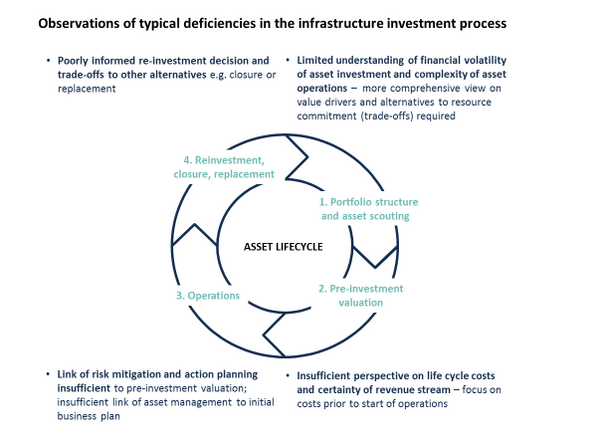
During establishing an asset portfolio structure and scouting assets, it might be worthwhile to establish a view on value drivers which are acceptable for an investment (e.g. one might not be willing to enter certain regulatory or political risks).
In the pre-investment evaluation, reviewing lifecycle costs and the revenue structure will shed some light on the stability of the business case. In case potential issues are discovered, technical or contractual mitigation options might exist.
Value levers in operations should tie in with the business case established in the pre-investment stage. This allows to manage asset operations in line with the investment rationale.
At the end of the asset lifecycle, major overhauls or replacements are required. It is important which ones should be conducted and how this links to the re-investment rationale or whether this extends the asset life.
Example ‘Portfolio structure and asset scouting’: In the absence of tangible infrastructure investment opportunities, an asset manager considered opportunities to invest into clean tech. The questions raised was whether these opportunities would exhibit infrastructure like cash flow characteristics. In case they would deviate from infrastructure characteristics could a premium be monetized to compensate for a higher risk exposure?
Example ‘Pre-investment evaluation:’: A strategic investor considered to repower a fossil power plant in the UK. The intention was to burn biomass and pocket Renewable Obligation Certificates (ROCs). At that time, there was a political debate to change the ROC allocation mechanism. Additionally, as the ROCs are traded, analysis conveyed that a change in the allocation scheme would significantly impact the certificate market price. Thus, the investor decided to postpone the investment decision.
Example ‘Operations’: An investor reviewed the key value drivers of a major highway project. The total traffic expected was in line with expectations. However, the mix of truck traffic vs. car traffic was off. Truck traffic was much more substantial than car traffic. The good news was that this lead to higher revenues than expected. However, maintenance costs were much higher than expected and the forecasted lifetime of the asset was reduced significantly. The investor initiated several initiatives to bring profitability back in line with expectations.
Example ‘Reinvestment, closure, replacement’: A strategic investor considered to renew its fleet of power plants. Therefore, the investment budget had to be defined. Renewals, capacity additions and re-powerments had to be timed. Analysing investment needs and run time expectations conveyed that in some instances, moderate investments would be sufficient to modestly extend the asset life. For other assets, the risk that main components would break during an extended asset life were so significant that an asset life extending investment would not be justified.
Therefore, it is important to establish a perspective how project value might be impacted prior to committing to an investment project.
A value perspective should be forward looking and hence apply predictive perspectives and methodology. Just extrapolating historic findings will not suffice.
Benefits of a volatility based financial perspective
The interconnectedness of global markets has increased. Hence, linear planning is less relevant in today´s environment. A volatility based financial perspective is necessary to gain insights into sensitivities and dependencies on key value drivers. Does this provide protection from value leakages in the future? No – future market developments are still uncertain. But a sound understanding allows to manage assets for superior performance across the asset lifecycle. It also allows to better integrate a value view with an operations perspective.

Are perspectives of strategic and financial investor different? Yes, they are – strategic investors focus more on strategic and operational questions; financial investors focus more on financial asset characteristics. However, going forward both perspectives require to be integrated further. If policy makers contribute their part to contain risk, more capital will flow into the sector opening new investment opportunities.
What are the benefits across the asset lifecycle?
- Portfolio structure and asset scouting: sound overall financial perspective, scouting action plan and investment priorities
- Pre-investment valuation: comparison of individual assets against investment concept, value decisions across time enabled, baseline for (future) performance management
- Operations: business case linked to operations, mitigation planning is enabled, prioritization of maintenance activities
- Re-investment, closure and replacement: holistic asset management view allows better (re-investment decision), feedback of historic operations data into finance function for better (future) asset operations
Applying a concise and stringent volatility based financial management rationale across the asset lifecycle will lead to better asset performance. It will also allow to identify investment opportunities which might be not as obvious as others. In a constrained opportunity space this is an important strategic advantage.
Commodity trading (3/2016)
Back to operations …: Opportunities for 2016/17
Commodity trading revenues are still being challenged after a weak trading year 2015 and optimistic expectations for early 2016. Overall the outlook remains modest with markets still exhibiting signs of past investments, the correlation to a low oil price and weakening demand due to different reasons. As trading revenues are not expected to get back to previous levels medium term, some operational levers and opportunities might be considered.
Commodity trading revenues in 2015 were down compared to the previous year. Attractive oil trading revenues could not compensate the overall contraction of the sector. Reuters estimates overall commodity trading returns of the 12 large investment banks to be 18 percent down to USD 5.6 BN. With some exceptions also trading houses are facing challenging conditions. An early 2016 recovery of prices expected by several risk investors and traders did not happen although volatility patterns could be monetized.
Challenging market situations to continue
Oil: Although the oil price impact on the supply-demand balance may seems exaggerated, a low price but volatile market conditions remain. An inflow of significant investment is needed to compensate natural oil production losses. Additionally, an increasing demand of 1-1.5 MMBD needs to be met. Whether this supply challenge will be met as well as a potential alignment of interests within OPEC will demine the future price environment.
Coal: Most recently, WoodMackenzie expects thermal coal consumption to be down 40% by 2035. This will have a significant impact also on market conduct.
Metals: Changing requirements and material innovation in manufacturing and automotive as well as slowing construction activity is impacting metals trading. Strategic market participants are already acting on this trend.
Softs: Not only supply-demand patterns across the BRIC countries will influence future market conditions. China as a key driver of demand. It has cut commodity consumption due to a dim economic outlook as well as changing domestic demand profiles. In softs however, demand remains high and supply positions have been established (e.g. in animal products).
Overall, difficult market conditions will remain. Volatility in oil provides trading opportunities. Increasing oil prices driven by supply-demand measures might cause some relieve also impacting other commodity classes. However, interest rate policies of the Federal Reserve (FED) as well as additional quantitative monetary measures of the ECB might still be a burden on the commodity price environment.
Efficiency improvements in trading not exploited yet
Operational improvement levers have already been addressed by commodity traders elevating the efficiency challenge from the divisional agenda to the corporate level. To get to the next level of operational excellence will be more challenging as this requires process innovations potentially supported by technology.
Also FICC operations of large banks have made significant cuts. However, the focus has been on cutting front office costs. But improvement potentials at middle and back offices have not been addressed to a similar extent. Trader support ratios and cost income ratios (CIR) at large investment banks still remain high. CIR are in the (high) seventies. Hence, JPMorgan estimates that at some large investment banks, costs at middle and back office need to be cut by 25-30% in order get the businesses back in line with post regulation RoE.
Middle and back office operations improvements
Operations should still be on the management agenda offering degrees of freedom not seen in the recent past. Here are some examples:
- Continue operational improvements and also facilitate cross opco best practice sharing: Middle and back office operations continue to be an important lever. Strengthening processes will allow to integrate with technology and will create a more resilient operating environment.
- Integrate dispersed and increasing industrial operations into ops agenda: As processing activities and industrial operations have increased, including these into the operational efficiency agenda is even more important compared to the past. Realizing improvement potentials without risking operational stability is however tedious compared to creating additional trading revenue.
- Improve mid and back office capabilities: Both activities should not only be viewed as cost positions but also as contributors to contain and manage risk exposure – not only market and credit risk but also operational risk. Given that banks need to restructure their FICC mid and back office operations – especially in Europe – allows to tap into a talent pool at attractive costs.
- Review integration of financing/ treasury and tax management into ops agenda: Integrating trade finance activities and the international taxation framework into the ops agenda adds value and is of strategic importance these days. However, in order to ensure seamless execution, a corresponding operating framework needs to be put in place.
Operations agenda supports overall strategic objectives
What will be achieved if a stringent operations agenda is followed?
- More attractive operating economics: Support ratios and support costs can be better understood and managed than in the past. Facilitating an internal exchange on operating economics and aligning these with the incentive system will lead to more attractive overall operating economics.
- More resilient business model: Clarity on processes and transparency of middle/ back office operations is not only increasingly demanded by equity and debt investors. It will also contribute to the stability of the business model impacting risk adjusted returns.
- Improved financing capabilities: As operational performance and effectiveness increase, financing capabilities will also be improved – a key strategic objective of commodity traders these days.
- Better alignment of financial performance levers with business and operating model: A supply chain set up in line with treasury and taxation considerations is essential for global commodity trading businesses and contributes directly to the bottom line.
Risk management (2/2016)
Taking risk management to the next level …
Risk management at large corporates has evolved from a qualitative exercise and compliance effort into a quantitative discipline. Additionally, it has been better integrated into the daily management reality of businesses. Is this set up made to cope with future risk challenges? There might be some upgrades which should be considered …
Risk management at large corporates has evolved significantly over the last few years. It has moved out of the insurance and compliance corner. It is supported by quantitative methodologies and supports key strategic decisions like portfolio management and day-to-day business decisions.
Risk management – what has been achieved?
By applying these practices, functional gaps between the risk management function, strategy/ corporate development and finance are being bridged. With the integration of a risk management perspective into the financial plan, performance can be measured and tracked in line with reporting cycles. A differentiation between business performance and external influences can be measured. Timely management action and intervention within and not at the end of the reporting period is possible. Hence, an issue and value based management approach can be followed more easily. But is this sufficient to cope with future risk management challenges?
Observations on risk management challenges …
Two observations can be made when reviewing the characteristics of an evolving risk environment and talking to risk practitioners and senior management.
- Evolving risk environment – ‘Disruptive risk events with potentially high impact have been quite frequent …’: The recent history has produced risk events which have come as a surprise. Some of these have not been on the risk management agenda or have been underestimated.
- ECB monetary policy: The change of monetary policy in the aftermath of the financial crisis has evolved from a risk to a reality impacting e.g. exchange rates, financing costs and availability of financing. Additional surprises have paved the way … rather than moving back to normal, expansive monetary instruments have been introduced and are being discussed which have been off limits before.
- Infections: Some years ago ‘pandemic’ was a new type of risk entering the risk inventory. The fear has become real that an infection might spread globally with large scale lethal impact. Since then, fears of spreading viruses have been on the agenda several times. Most recently there has been a debate about the Zika virus and the impact and threat it might have in the context of the 2016 Olympic games.
- Cyber: This was considered to be a topic to be under control if a sound business continuity plan, IT set up and insurance coverage has been put in place. However, even intelligence agencies have been hacked. Most recently Apple´s operating system has been hacked enabling large scale access to user information and meta data, calls and messages. This has not considered to be a likely scenario given Apple´s focus on IT security. One might imagine the damage a similar event might cause especially in a digital world in which industrial and personal devices get increasingly connected. Maintaining resilience of commercial systems and public infrastructure is moving up on the priority list.
- Terrorism: Terrorism has been a phenomenon which seemed to apply only to high risk global regions. Sadly, it has developed very quickly into a reality for modern societies with no recipe for an instant cure. Who would have thought this to be the case?
- Oil price: Only in the recent months, the oil price has exhibited movements not expected previously. In the beginning of 2016, risk investors lined up large sums of capital behind the conventional wisdom for the oil price development in Q1/2016. They were proven wrong.
This is just a selection of events and developments – more examples could be mentioned.
- Internal risk management capability set – ‘Quantitative capabilities need to complemented by qualitative assessment expertise …’: Historically, companies where challenged to get quantitative risk management capabilities on board. These days it is becoming more eminent that quantifications also have their limitations. Risk analysts and management might be blind sighted by an automatism how to look at risks.
But what needs to be done and how can these challenges be met?
Understanding risk and not only calculating it …
Risks need to be genuinely understood. Only this allows to also package them into an appropriate quantitative framework and interpret how they evolve over time.
A risk culture needs to be established throughout the organisation. The intention is not to avoid risks but to take calculated risk for profit and to be prepared for higher impact events. Potential starting points are …
- @ risk management department level: The necessity of complex and extensive quantification exercises should be reviewed. Quantification exercises might be balanced with (additional) qualitative risk assessment capabilities and capacities.
- @ business management level: Observations and impact assessments provided by risk management should be regular discussion topics at least in the context of planning cycles. In day-to-day management, they need to influence management action and initiatives.
So, the next level of risk management evolution is not a substantial one but rather a corrective one. Organizational challenges and implementation hurdles should however not be underestimated.
Digital transformation (1/2016)
The forgotten customer
Digitalization has become the new management buzzword. Companies have established digitalization initiatives, conducted digitalization strategies and have established digitalization departments. Is this sufficient to be successful in a transforming market environment? This article highlights some perspectives what companies should keep in mind as they head down the digital transformation path.
‚Digitalization’ has entered the top management agenda of nearly any larger corporation. Responsibilities have been defined and initiatives are under way. More frequently the question gets asked: ‘Are we heading into the right direction?
Customer perspective cut short in digitalization initatives
Analysing how digital initiatives are being set up in a lot of cases convey the following patterns:
- Staff function: ‘Digital’ is in several cases organised as a staff function. The businesses tend to be on the side-lines rather than in the driver seat
- Manufacturing and supply chain focus: Digital initiatives are focused on manufacturing and supply chain activities
- Deployment of apps: Customer facing digital initiatives tend to focus on the development of ‘apps’. This may be delivered together with a proprietary technical standard
Is this appropriate? Where are potential white spots and will the digital initiatives ensure a stronger competitive position and value capture?
Recalibrating around competitive dimensions
‘Digital’ needs to address the whole value chain as technology offers the opportunity to be more effective and efficient with any activity. Also, interdependencies throughout the value chain need to be taken into account. But where should be the priority and what are the most pressing competitive dimensions?
- Production cost?
- Supply chain costs?
- Complexity?
- R&D and time to market?
- Other?
Any of the above might be supported by a digital technology dimension and is part of an Industry 4.0 rationale to innovate the value chain.
Unique opportunity to build a true customer relationship
However, technology offers the opportunity to innovate the end-customer relationship or to establish one if it has not existed before. Information and transaction costs of establishing and maintaining a customer relationship are not as restrictive as this has been the case in the past.
- Broad reach: Customers can be approached any time and in any geography with a customized message
- Close interaction and automated operations: Through a well-structured interaction much more targeted messages can be sent and automation of routines is possible (e.g. chat bots). Behavioural patterns of customers can be captured and linked to buying rationales and timing
- Communities can be leveraged to make relationships for customers more relevant: Peer-behaviour and referrals are relevant buying factors in a B2C relationship. In B2B relationships adjacent offerings can be positioned more prominently which are identified as an integrated value proposition (e.g. services, financial products)
What implications can be drawn for some industrial sectors?
Understanding the customer value proposition will change the delivery …
- Electric devices, furniture and construction materials/components: These industries sold traditionally through wholesale channels and rely significantly on their sales network for customer intelligence. Now, for the first time these industries can establish end customer relationships and deploy commercial or technology platforms to make a bigger market impact
- FMCG: For some large FMCG firms a 'charged' customer relationship has become already a reality. Social media is used to engage with communities proactively. Apps are used to nurture individual customer relationships and to impact brand loyalty
- Financial services: As the sector is transforming it will reorganise around customer value. Costly distribution structures will no longer be required to interact with the customer, product innovations can be deployed much faster and at lower costs. Compliance with regulatory requirements can be tracked much more easily
- Mobility: This is no longer just a pure hard ware or service play. Both plays are integrating. Lifestyle considerations become more important with regard to the pure transportation aspect
Especially in online-retail and online technology, the customer is in the center of the business model evolution. Strategic business model considerations meet explorative business model evolution cycles. As such not a deterministic marketing approach is followed. Explorative marketing is being pursued supported e.g. by big data analyses, machine learning, continuous price exploration and testing.
… and enable companies to maintain their relevance in the market
As the customer relationship 'gets charged', companies will be in better position to prove their relevance. This will be the basis for continued profitable growth. If this is not being addressed other market participants will challenge and take over the customer relationship over time.
New entrants are also quite active to develop new ground (e.g. Apple Pay, Uber, AmazonFresh, ShaveClub, Google Car). Technology should be employed driven by commercial requirements (and not the other way around).
Creating value through commercial platform rather than fragmenting the market with proprietary standards should be the leading thought for developing a customer value proposition. The latter will limit the benefits of developing commercial and technology networks (IoT) and hence will undermine the customer value proposition.



